THE NEXUS of people and planet



At DQS, we empower businesses to achieve excellence in integrated management systems (IMS) through our comprehensive certification programs. With our proven expertise and global recognition, you can unlock a world of opportunities and demonstrate your commitment to quality, environmental sustainability, and occupational health and safety.

IMS offers a seamless method for overseeing quality, environmental sustainability, and employee welfare. By obtaining IMS certification from DQS, you can showcase your dedication to integrating these vital elements of your enterprise into a unified structure that promotes efficiency, minimises risks, and boosts your standing.
We understand that every organisation is unique. That’s why our IMS certification process is tailored to fit your specific needs and requirements. Our team of experienced auditors works closely with you, ensuring that your systems are robust, compliant, and aligned with international standards.
Our IMS certification offers a multitude of benefits for your organisation:
• Streamline processes: Eliminate redundancies and optimise workflows across different management systems, saving time and resources.
• Improve risk management: Identify and mitigate risks proactively, ensuring the safety of your employees, protecting the environment, and safeguarding your business reputation.
• Boost stakeholder trust: Demonstrate your commitment to quality, environmental sustainability, and occupational health and safety to customers, employees, and regulators.


• Drive continuous improvement: Foster a culture of innovation and continual enhancement, driving operational excellence and business growth.
• Expand market opportunities: Open doors to new markets and business collaborations that prioritise organisations with robust IMS certifications.
By choosing DQS, you gain access to an extensive global network, industry-leading expertise, and a reputation for excellence. Our auditors have in-depth knowledge of diverse sectors, allowing us to cater to your specific industry requirements. We go beyond certification, providing ongoing support and guidance to help you maintain your IMS, adapt to evolving standards, and stay ahead of the competition.

Welcome to the DQS Academy, a globally and nationally accredited training provider specialising in comprehensive ISO training courses. Our courses cover a wide range of disciplines, including Quality, Health, Safety, Environment, Food, Risk Management, and Information Security Management management. With a focus on management system standards and processes, our experienced facilitators will equip you with the knowledge and skills necessary for the intent, implementation, and auditing of various management systems.
We offer training programs that provide a thorough understanding of formal, international management system standards. With over 20 years of experience in delivering industry-leading business and international standards training, DQS Academy is well-equipped to provide expert guidance in management system standards.
Our courses are structured into four consecutive levels:
• Awareness: These courses are designed to develop your understanding of a specific management system.
• Implementation: For individuals responsible for implementing the management system, these courses provide in-depth knowledge and practical guidance.
• Internal Auditor: Internal Auditor Course is designed to capably conduct internal assessments
• Lead Auditor: These courses are targeted at individuals responsible for auditing the management system, equipping them with the necessary skills to conduct effective audits.

Some Of Our Featured Training Topics Include:
• ISO 9001:2015 - Quality Management Systems
• ISO 14001:2015 - Environmental Management Systems
• ISO 45001:2018 - Occupational Safety & Health Management Systems
• ISO 22000:2018 and FSSC 22000 - Food Safety Management Systems
• SO 27001:2022 - Information Security Management Systems
• ISO 13485:2016 – Medical Device Quality Management Systems
Expanding
• ISO 31000:2018 - Risk Management Systems
• IMS – Integrated Management Systems

• ISO 55001:2014 – Asset Management Systems

• ISO 22301:2019 – Business Continuity Management Systems
• AA1000 - Assurance Practitioner Certificate
• HACCP / SANS 10330 - Hazard Analysis Critical Control Point
Our fortunes in the economy, generally, and in the renewable energy sector specifically, wax and wane with loadshedding, albeit in a converse relationship. We find ourselves back to maximum demand for energy solutions as the frequency of loadshedding surges, while our customers toil angrily in the dark or with the smell of diesel fumes in their nostrils, and their financials in a mess.
Diesel is the story of the day as Eskom burns away R12.4-billion in diesel (according to Business Maverick). The Diesel Syndicate, key among the organised crime syndicates operating within the energy sector and feeding off Eskom, is clearing flourishing.
Battery energy storage is emerging as the principal solution for Eskom and for industry, with solar PV a much-needed addition to try and square the economics, but not everyone has the roof or ground space, and not everyone has sufficient line capacity, the two most common constraints to rolling our a critical mass solar PV solution to match loads. And so, due to the cost of batteries, systems are expensive relative to utility savings, but thankfully still very attractive when diesel cost is factored in.
At the current pace of energy project roll-out, just about every major energy customer in the country will have some sort of alternative energy solution in place within the next five years.
Eskom and the municipalities should be hard at work revising their business models and finding ways to get involved and find new revenue streams that add value to an inevitably and rapidly changing energy landscape.
Yours,
Publisher
In an unprecedented move and under the umbrella of BUSA, CEOs of South Africa’s largest companies from all sectors are coming together in a coordinated and committed way. Their commitment is to work together urgently to address our nations key challenges: energy, transport and logistics as well as crime and corruption (page 8).
As South Africa ramps up its roll-out of renewable energy, it is now confronting the same challenge faced by countries across the globe. Depleted grid capacity in resource-rich areas is making it increasingly difficult to connect new renewable energy projects to the grid, particularly in the Northern, Eastern and Western Cape (page 38).
Driving a meaningful new energy vehicle (NEV) transition in South Africa will require a careful balance of incentivising a sustained shift in domestic market demand to NEVs; establishing an appropriately aligned, renewable energy-based charging infrastructure and supporting a shift in vehicle production (page 12).
Unless ambitious public policy action is taken, electric vehicles (EVs) will remain the privilege of the few for the foreseeable future. A dual strategy is necessary. It involves promoting the purchase of entry-level EVs in the passenger car market while simultaneously fostering their introduction in public transport (page 16).
Private participation in infrastructure and PPPs help bridge financing gaps while delivering sustainable infrastructure in developing economies — stimulating economic recovery. But how can PPPs be the “right tool” to support sustainable and resilient infrastructure development? Find out on page 32
Enjoy this issue!
Alexis Knipe Editor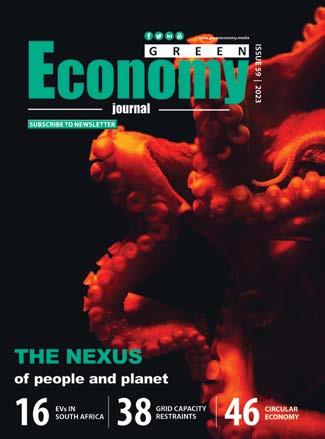
EDITOR: Alexis Knipe alexis@greeneconomy.media
CO-PUBLISHERS: Gordon Brown gordon@greeneconomy.media
Alexis Knipe alexis@greeneconomy.media
Danielle Solomons danielle@greeneconomy.media
LAYOUT AND DESIGN: CDC Design
OFFICE ADMINISTRATOR: Melanie Taylor
WEB, DIGITAL AND SOCIAL MEDIA: Steven Mokopane
SALES: Gerard Jeffcote
Glenda Kulp
Nadia Maritz
Tanya Duthie
Vania Reyneke
PRINTERS: FA Print
GENERAL ENQUIRIES: info@greeneconomy.media
ADVERTISING ENQUIRIES: alexis@greeneconomy.media
REG NUMBER: 2005/003854/07
VAT NUMBER: 4750243448
PUBLICATION DATE: August 2023
www.greeneconomy.media
To access the full report in our Thought [ECO]nomy report boxes: Click on the READ REPORT wording or image in the box and you will gain access to the original report. Turn to the page numbers (example below) for key takeouts of the report.



Trade, Industry and Competition Minister Ebrahim Patel has launched the Energy One Stop Shop and Energy Resilience Fund. This is part of the Energy Mitigation Strategy through the National Energy Crisis Committee.
The Energy One Stop Shop was developed to address a key constraint that energy developers face, namely that the many regulatory and other measures that need to be complied with, can and do slow down approval of energy supply projects.

“While the presidency is exploring ways to simplify these processes, we have seen that having a dedicated resource available to the private sector, to address blockages, has worked in other parts of the economy.”
Patel said government is committed to fostering a resilient business environment and accelerating private-sector investment in electricity generation to secure a stable energy future.
To contribute towards easing the impacts of loadshedding, the dtic, Industrial Development Corporation (IDC) and the National Empowerment Fund (NEF) have established a blended funding facility, the Energy Resilience Funds. These will support any business adversely affected by the energy crisis across all sectors of the economy.
President Ramaphosa recently announced that government has made significant progress in several areas of generating new energy, such as building new generation capacity and transforming the industry through regulatory reforms.
The president said that by stabilising Eskom’s power stations’ performance and reducing demand during the winter, a worstcase scenario was averted, despite ongoing loadshedding.
According to the president, Eskom has unlocked almost 400MW from companies with spare capacity of power added to the grid and the government is in the process of adding another 600MW.
“We are fast-tracking the procurement of new generation capacity from renewables, gas and battery storage. Later this year the first three projects from the emergency power programme are expected to connect to the grid,” he stated.


The president said it is encouraging to see more municipalities allowing their customers to feed surplus electricity into the grid when they have excess power, which will encourage businesses to invest in alternative energy.
NERSA says it agrees with the draft ministerial determination to procure 1 000MW of new generation capacity from the cross-border procurement agreement.
“New generation capacity must be procured or purchased to contribute towards energy security and accordingly, up to 1 000MW should be procured from the SADC region from a range of technologies/sources,” NERSA said. “The range of energy producers from the region will either be utilities from the host countries or independent power producers that are legally operating within the host countries.”
The energy capacity shall be procured by Eskom Holdings SOC Ltd and shall entail the procurement of electricity through one or more processes that are fair, equitable, transparent and cost-effective, and the form of which shall be determined by Eskom; and the conclusion of Power Purchase Agreements in respect of the electricity, for which the duration will be agreed upon between Eskom and the energy producers from the region. SAnews.gov.za

A Heads of Agreement has been concluded with the intention to launch a “SA-H2 Fund” (SA-H2). SA-H2 is an innovative blended finance fund, that will facilitate the development of a green hydrogen sector and circular economy in South Africa. The Fund is supported by Climate Fund Managers and Invest International B.V. (II) of the Netherlands, Sanlam Limited, the Development Bank of Southern Africa and the Industrial Development Corporation of South Africa (IDC), in collaboration with other strategic partners. The SA-H2 Fund initiative will aim to secure US$1-billion in funding, to be raised directly in South Africa or indirectly via other channels. Its focus will be to fast-track the mobilisation of funding towards the development and construction of large-scale green hydrogen infrastructure assets across South Africa.
“Succeeding in a just transition to cleaner energy rests on our ability to create a viable marketplace that attracts and mobilises public and private capital, and this fund will do just that. We will create and use innovative blended finance architecture and structuring to build a substantial pipeline of green hydrogen projects in South Africa. This will give private sector developers access to risk capital from an early stage of development, throughout construction and into operations,” says Catherine Koffman, group executive: project preparation, DBSA.
The African Continental Free Trade Area (AfCFTA) holds the power to unleash an economic revolution – ushering in unparalleled progress and prosperity like never before. For South Africa and for most of the continent, a key aspect for reaping the full benefits of AfCFTA and securing a brighter future lies in moving quickly to ensure a stable energy supply.
AfCFTA, phase 1, is seeing incremental implementation despite some key unresolved negotiations on rules of origin and tariff schedules, has the potential to become an unparalleled titan of free trade agreements. It seeks to gradually eliminate tariffs on 90% of goods and reduce trade barriers. The UN Conference of Trade and Development estimates that the agreement could boost intra-African trade by about 33% and cut the continent’s trade deficit by 51%.
To truly unlock the benefits of AfCFTA, the whole continent must make a comprehensive energy strategy top priority. Solving the energy crisis cannot be achieved in isolation; it requires collaboration between governments, private sector entities and international partners.
It is heartening to note that the Presidential Climate Commission has unequivocally underscored the urgency of securing a sustainable
“Further, this fund is a significant addition to national efforts to leverage our existing renewable energy infrastructure. With a national target of US$250-billion investment in green hydrogen by 2050, this sector is projected to amplify the development impact of the renewable energy industry.”
Joost Oorthuizen, CEO of Invest International: “SA-H2 is a showcase of how public, private, international and local parties can join forces to create a catalytic effect on the development of an exciting new sector. Green hydrogen projects in South Africa can contribute to local sustainable development and support the energy transition locally as well as in export markets. While deploying its funds, Invest International makes efforts to demonstrate strong environmental and social commitment, strive for local impact and inclusive growth, and combine the expertise of Dutch and South African businesses.”
Joanne Bate, COO, IDC says: “The development of this new industry will support the longer-term energy security priority and the just energy transition contribution will proactively address socioeconomic development. South Africa will position itself as a globally competitive player in this industry. More importantly, green hydrogen will enable the local decarbonisation of hard-to-abate industrial sectors.”
energy supply. It has stated that energy planning should consider climate change mitigation due to the magnitude of climate risk.
The commission also emphasised that electricity planning should be based on least-cost pathways. All reviewed models demonstrated that the least cost energy model would involve investments in variable renewable energy (wind and solar), storage (batteries and pumped hydro) and peaking support.
Government must urgently expand renewable energy production and upgrade the grid infrastructure. To attract private investment, policy frameworks must be streamlined.
We must prioritise developing the capacity of the energy sector. By nurturing a skilled workforce, we can accelerate project implementation. Effective partnerships with educational institutions and industry stakeholders are crucial to address the skills gap.
The effective implementation of AfCFTA will streamline trade regulations, customs procedures and remove barriers. Through regional cooperation and market integration, it can enable economies of scale, attracting investors to tap into Africa’s expanding energy demand. This could fuel more energy sector investments, establishing Africa as an energy secure region and an industrial powerhouse.
By Wrenelle Stander, CEO of WesgroSAWEA has noted the court’s ruling to dismiss the urgent interdict in relation to the interim grid capacity allocation rules (IGCAR). The ruling will enable the industry to deliver much needed new generation capacity, as the state utility is able to grant the required budget quotes in line with the IGCAR.
The process to allocate grid access impacts projects differently, however, as it currently stand the IGCAR will allow the urgent deployment of new generation. As such, and in line with the ruling, SAWEA has reaffirmed its commitment to working with all key stakeholders to accelerate the connection of shovel-ready projects with a view to alleviating the energy crisis.
SAWEA encourages progressive industry discussions with the System Operator regarding the optimisation of the grid including the allocation of grid capacity, in line with the industry’s objective to develop a favourable regulatory environment for the rollout of renewable energy. As an association advocating for the advancement of the wind energy sector, SAWEA continues constructive engagement with all key stakeholders, including the presidency, NECOM, and Eskom to find solutions that support the construction or expansion of utility scale wind projects to help solve the country’s energy crisis.
The Energy Institute and partners KPMG and Kearney recently released the 72nd annual edition of the Statistical Review of World Energy*. Global energy data themes for 2022, include:
Primary energy
• Primary energy demand growth slowed in 2022, increasing 1.1%, compared to 5.5% in 2021, and taking it to around 3% above the 2019 pre-Covid level.
• Renewables’ share of primary energy consumption reached 7.5%, an increase of nearly 1% over the previous year.
Carbon emissions
• Carbon dioxide emissions from energy use, industrial processes, flaring and methane (in carbon dioxide equivalent terms) continued to rise to a new high growing 0.8% in 2022 to 39.3GtCO2e, with emissions from energy use rising 0.9% to 34.4GtCO2.
• In contrast, carbon dioxide emissions from flaring decreased by 3.8% and emissions from methane and industrial processes decreased by 0.2%.
Renewables
• Renewable power rose 14% in 2022 to reach 40.9EJ. This was slightly below the previous year’s growth rate of 16%.
• Solar and wind capacity continued to grow rapidly in 2022 recording a record increase of 266GW. Solar accounted for 72% (192GW) of the capacity additions.
Electricity
• Global electricity generation increased by 2.3% in 2022 which was lower than the previous year’s growth rate of 6.2%.
• Wind and solar reached a record high of 12% share of power generation with solar recording 25% and wind power 13.5% growth in output.
• Coal remained the dominant fuel for power generation in 2022, with a stable share around 35.4%.
• Natural gas-fired power generation remained stable in 2022 with a share of around 23%.
• Renewables (excluding hydro) met 84% of net electricity demand growth in 2022.
*The Statistical Review of World Energy has been published by bp since 1952. It was announced in February that it would pass to the Energy Institute, KPMG and Kearney.
Release by Scatec signed an agreement to raise USD102-million in funding from Climate Fund Managers to further accelerate its growth ambitions. Release was established by Scatec ASA in 2019 to offer a flexible leasing solution of pre-assembled and modular solar and battery equipment for the mining and utilities market.
The company invested in Release via its Climate Investor One fund; a blended finance vehicle focused on renewable energy infrastructure in emerging markets. CFM will contribute USD55-million in equity for a 32% stake in Release. Scatec will retain the majority shareholding of 68%. CFM will also provide shareholder loans totalling USD47-million, part of which will be on concessional terms.
Release is experiencing good traction in the market, particularly towards African utilities. It has projects in operation and under construction in Cameroon, South Africa, Mexico and South Sudan with a total capacity of 47MW solar PV and 20MWh of battery storage and has additional contracts for 35MW solar PV and 20MWh of storage in Chad, in addition to maturing its advanced pipeline.
Release will replicate its rapid deployment model to address shortfalls in local grid power supplies throughout the region.
“The new shareholder funding will be supplemented by Release through additional debt and guarantee facilities that are currently in advanced negotiations. This gives us the financial foundation we need to meet the strong demand for our flexible leasing model, for easily deployable renewable power plants,” says Release CEO, Hans Olav Kvalvaag.
Release will be accounted for as a joint venture investment in the group accounts of Scatec, which will generate an accounting gain of approximately USD40-million in the consolidated financials at closing. Closing of the transaction is expected in the third quarter of 2023, subject to customary conditions precedent.
National Energy Regulator of South Africa (NERSA) has approved that the National Transmission Company of South Africa Limited (NTC) be issued with a licence to operate a transmission system within South Africa.
“The NTC is envisioned to be an independent transmission system operator incorporating, inter alia, the currently nonlicensable but integrated functions of network provision, system operation and planning.

“The NTC’s independence is an important signal to all stakeholders, including investors that they will have nondiscriminatory access to the transmission system,” NERSA said.
Furthermore, the NTC is responsible for ensuring grid stability, to which end, it is allowed to buy and sell power, but not for profit. The NTC is a wholly owned subsidiary of Eskom, which was established as per government objectives and will perform the following key integrated roles to ensure the integrity of the interconnected power system:
• Transmission Network Service Provider

• System Operator
• Transmission System Planner
• Grid Code Secretariat
The white paper, titled “On Electric Power Communication AllOptical Network, Accelerating Digital Transformation of Electric Power”, was released at the Huawei Sub-Saharan Africa Electric Power Summit, which formed part of Enlit Africa 2023. It outlines how the power communication network is the basis for automatic power grid dispatching, market-oriented network operations and modernised management. Such a network is an important means to ensure stable and economical operations of the power grid as well as the core infrastructure of the power system.
“Digital technologies are vital to leading the transition to a more sustainable energy sector,” said Victor Guo, president of Huawei Sub-Saharan Africa Enterprise Business Group. Using the expertise it has gained from more than three decades in the communication sector, he added that Huawei is ideally placed to “pave a digital way to a global energy transition.”
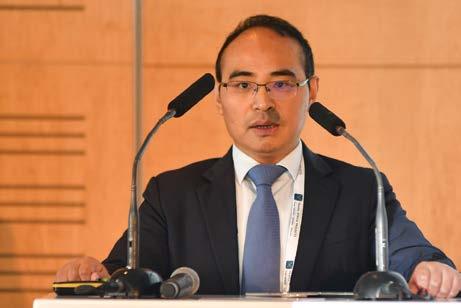
Edwin Diender, chief innovation officer, global electric power digitalisation business unit, Huawei Technologies concurred. “Energy transition and digital technology combined are able to drive us towards carbon neutrality,” he said. “We want to leverage our experience in the worldwide web of communications into a worldwide web of energy.”
According to Diender, achieving that will require a mindset shift from many players in the energy sector. “Where having a smart grid is often the end-stage for the energy industry and electric power companies, we see much more potential,” he said. “With such aspiration, the information of the power grid becomes more significant, more meaningful. And this digital journey will lead to more sustainable future power systems.”
“We’re looking at capabilities from our past and seeing how they can be applied to the energy sector,” he added.
As Wenchen Wang, solution manager of transmission and access, pointed out, the organisation is ideally positioned to do so.
“Huawei makes full use of its technological prowess to continuously explore the electric power industry,” she said. “Together with the upstream and downstream of the industry chain, it has provided secure, stable, and reliable all-optical communication network solutions for countries and regions such as China, Thailand, Brazil, the UAE and Austria, accelerating the digital transformation of the electric power industry and reshaping industry productivity.”
Diender added that utilities need to embrace that digital transformation is an ongoing journey that can’t be achieved as a one-off project or by adopting specific technologies. That journey starts with digitisation (the switching from analogue to digital meters), moves on to digitalisation (building a network of smart meters), and ultimately results in full digital transmission (which might look like having full digital twins of every meter on the grid).
As Diender noted, a lot of existing communications technology can be repurposed to ensure a more sustainable, carbon neutral grid. “Parts of this journey have not been taken yet, but a lot of work has already been done,” he said. “There’s a lot of communication technology already within the energy industry.”
Taking this approach, he said, could also open new revenue streams for utilities. They could, for example, use the technological backbone needed for digital transformation to become fibre to the home (FTTH) provider in partnership with internet service providers. There is also potential from a data perspective.
But for that technology to be used effectively and sustainably, partnerships will be crucial. “Alone you can go very fast, but together you can go much further,” he concluded.

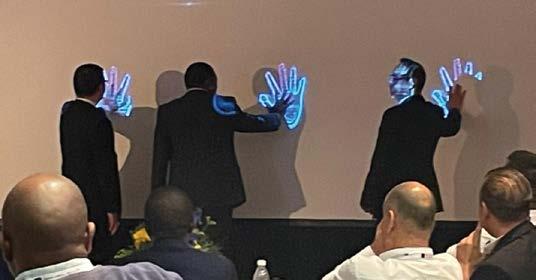
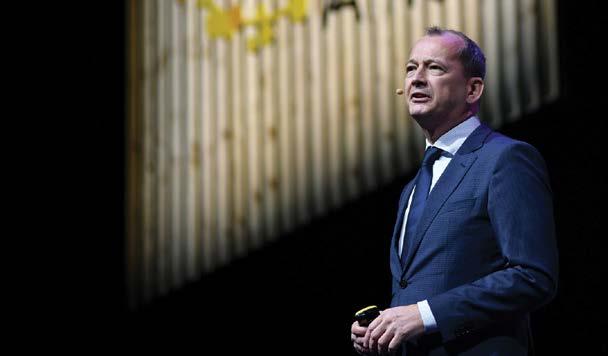
Energy transition and digital technology combined are able to drive us towards carbon neutrality.Edwin Diender, Chief Innovation Officer, Global Electric Power Digitalisation Business Unit, Huawei Technologies. Victor Guo, President of Huawei Sub-Saharan Africa Enterprise Business Group. Huawei releases the white paper at Enlit 2023.
A white paper released by Huawei and IDC has underlined how significant communication technologies will be in building the sustainable, carbon neutral energy grids of the future.
At a meeting held in June 2023, the South African Government and organised business agreed to to form a partnership, with appropriate engagement and oversight structures, to actively work towards removing obstacles to inclusive economic growth and job creation.
Various government departments, relevant state-owned enterprises and other appropriate structures will collaborate on clearly-defined initiatives with organised business, represented by numerous CEOs under the oversight of Business for South Africa (B4SA), the implementation platform for Business Unity South Africa (BUSA).
This initiative builds on the success of prior collaborations such as the Covid-19 response, where government and business worked together to implement a nationwide vaccine rollout.
President Ramaphosa said, “This initiative will make a real and marked difference in rebuilding our economy and setting it on a path of sustained inclusive growth. It is driven by a shared determination to overcome the severe challenges we currently face and to mobilise the country’s substantial capabilities towards the achievement of that goal. We welcome this commitment from business and undertake as government to work to ensure the success of this partnership.”
In an unprecedented move and under the umbrella of BUSA, CEOs of South Africa’s largest companies from all sectors are coming together
in a coordinated and committed way. Their commitment is to work together urgently to address key challenges and ensure the country achieves its potential of inclusive growth and job creation.
Said Adrian Gore, BUSA’s vice president, “South Africa has significant unrealised potential and this partnership agreement underscores business’ belief in our country and is a firm commitment to achieving sustainable and inclusive economic growth. Business, working together with all partners, is ideally positioned to ensure a better future, by turning the flywheel for the benefit of all.”
Minister Ntshavheni said, “In line with our commitment to mobilise the resources and capabilities of social partners to enable collective action to address the challenges facing our country, government welcomes the support of business in three priority focus areas –energy, transport and logistics as well as crime and corruption. This will enable joint action, alongside other social partners, on these critical challenges to set our country on a path to recovery.”
B4SA has made significant progress in establishing the three priority workstreams to work closely with government in implementing the urgent necessary actions.
Martin Kingston, chair of the B4SA steering committee, commented, “B4SA’s three priority workstreams are fully mobilised and, through joint collaboration and strategic partnerships with government, are focused on articulating and delivering a critical path to recovery, building societal and business confidence, as well as supporting government to deliver on these interventions. We are expecting to make considerable progress in the short term to realise collective benefits and set us on a sustainable path which capitalises on the country’s significant potential.”
Considerable progress has been made in the following areas:
• Energy. Advance collaboration, through the National Energy Crisis Committee (NECOM), to end loadshedding and achieve energy security. This will be done by supporting a drive to close the current energy capacity gap and build confidence in restoring energy security. Additionally, business has agreed to further capacitate NECOM to develop a confidence building national communication plan that is credible and transparent, supported by business and with visible and demonstrable actions.
• Transport and logistics. Stabilise and improve operational performance on key trade corridors, mobilising private sector resources and accelerating implementation of the National Rail Policy to close the capacity gap. Work is underway to immediately align and integrate business’ efforts into government’s Freight Logistics Roadmap, and developing work plans, deliverables and timelines while also integrating the private sector into the recently formed National Logistics Crisis Committee (NLCC).
• Crime and corruption. Government is reasserting the primacy of the rule of law and is in the process of strengthening the Investigating Directorate (ID) in the NPA and implementing intelligence, policing and other reforms in response to the recommendations of the State Capture Commission of Inquiry into State Capture. Business will provide support on a carefully governed arms-length basis. The Joint Initiative to Fight Crime and Corruption (JICC) has been established as the delivery mechanism to implement related interventions.
The workstream priorities will be continuously reassessed and reprioritised and, in the future, additional focus areas, such as water and infrastructure, may be brought into scope.

Business and government will explore ways to advance cooperation on the jobs agenda and identify what areas of collaboration or existing programmes can be significantly scaled in the short term.
Cas Coovadia, BUSA’s CEO, concluded, “Business is ideally positioned to ensure a better future for the benefit of all, which makes this partnership agreement with government critically important. South African business leaders are committing to contributing considerable skills and resources and, as a matter of urgency, work through all relevant partnership structures to address our country’s priorities. Ultimately, success will lead to a significant impact on GDP growth and job creation and will re-instill confidence amongst all stakeholders”.
The shortlist of CEOs who will be leading business’ participation in the workstreams includes Fleetwood Grobler, Nolitha Fakude, Mxolisi Mgojo, Andrew Kirby, Jannie Durand, Neal Froneman and Paul Hanratty. Other leaders will be added to the list over time.
Success will lead to a significant impact on GDP growth and job creation.

South Africa is a country with abundant fossil fuel resources that currently make up a big part of the energy sector and the economy. However, these carbon intensive resources pose a significant risk to human health, the environment and the country’s competitiveness. South Africa is also particularly vulnerable to the negative impacts of climate change, witnessed recently in the devastating floods that affected Kwa-Zulu Natal, while other parts of the country experienced drought.
South Africa faces considerable climate and energy-related risks. These include shortages of electricity supply, underinvestment in the electricity system, as well as physical, social, and transition risks. Embracing new economic opportunities in green technologies can drive industrial development, innovation, and economic diversification, This would lead to a sustainable and economically resilient future, characterised by decent work, social inclusion, and lower levels of poverty.
In considering the implications of a transition to a lowcarbon economy and a climate resilient society, the concept of a just transition takes centre stage. Just Energy Transition (JET) is about moving towards a lower carbon, greener future while enabling the creation of new job opportunities for those displaced by the replacement of coal by cleaner technologies. This is premised on easing the burden decarbonisation could pose to those who depend on high-carbon industries.
President Cyril Ramaphosa has said of the JET: “For transitions to be just, vulnerable workers and communities need to be included in designing solutions. These same constituencies must share the benefits and not just the risks of transitions.”
By Supporting and funding innovations in alternative, cleaner and greener energy innovations, the Technology
Innovation Agency (TIA), an entity of the Department of Science and Innovation (DSI) is committed to supporting the development of technological innovations that will assist the country to transition to a low carbon future, including mitigation and adaptation strategies that will improve climate resilience resulting in a competitive and sustainable economy. These will contribute significantly to our government’s energy objectives and goals.
The mandate of TIA is to promote the development and exploitation of discoveries, inventions, innovations, and improvements in the public interest. TIA provides financial and non-financial support for innovations in various sectors of the economy including, the bioeconomy (health, agriculture, industrial biotechnology, and indigenous knowledge systems), advanced manufacturing, energy, ICT, and natural resources (mining, water, and waste management). Through supporting innovation and the development of local intellectual property, South Africa can transform from a resource-based economy to a knowledge economy.
TIA has a critical role to fulfil as an Industry Builder. Industry Builders focus on transforming an economy by supporting the development of new sectors or technologies. An important factor in this is bridging the innovation chasm between research and commercialisation. In bridging the innovation chasm, TIA is an active funder, connector, facilitator, and enabler in the National System of Innovation (NSI) and industry. TIA is pursuing opportunities to position itself as the leader in the innovation discourse around the JET and climate resilience. The agency seeks to form partnerships with like-minded organisations and individuals to collaborate in addressing the challenge of climate change.
Through funding and support instruments of the agency, TIA has invested in various innovations that will respond to the country’s energy challenges and would contribute to the transition to more sustainable and safer energy technologies. These locally developed technologies include innovations funded through the Energy focus area and the Global Cleantech Innovation Programme (GCIP).

The uYilo eMobility Innovation Cluster Programme (uYilo) is a multi-stakeholder initiative established by TIA to facilitate an enabling environment that would support the increased uptake of electric mobility vehicles. In its ten years since inception the programmes has continued to create technology solutions and deploy innovative business models, support a human capital skills base to support innovation as well as commercial activities and commercialise battery electric vehicle technologies, products and services.
uYilo is at the Nelson Mandela University in Gqeberha; the Programme’s activities include government lobbying, industry engagement, pilot projects, capacity development, enterprise development and thought leadership.
uYilo’s facilities and expertise comprise of national accredited battery testing, materials testing, electric vehicle systems and a smart grid ecosystem that serves as a live testing environment for inter-operability of the various system components of the smart grid.
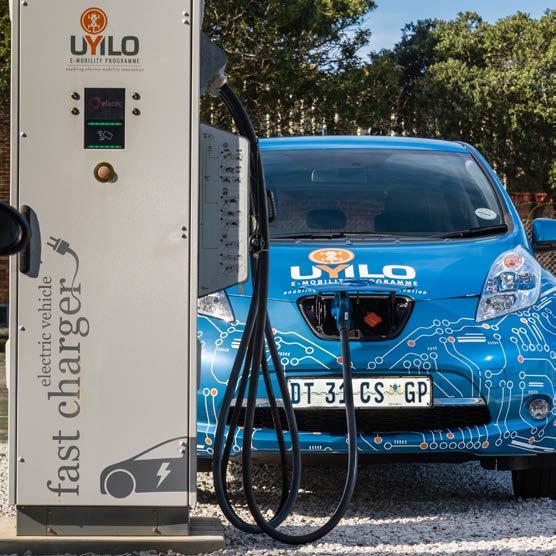
The Programme’s uYilo KickStart Fund continues to support products and service development by providing much needed funding for applied R&D. To date, about R11,5 million of funding has been provided through this Fund.


The MISER Hydraulic Hybrid Transmission (HTS) is an innovative energy efficient recovery system aimed at saving fuel for vehicles, particularly heavy-duty vehicles. The system was developed by Ducere Holdings (Pty) Ltd, a company specialising in the efficient use of energy by developing energy recovery and deployment technologies within the automotive industry.
The MISER is a new, hydraulic, efficient and automated transmission that achieves fuel savings and reduces emissions by optimising engine performance and regenerative braking. The ability of the MISER transmission to be both a series and a parallel system gives it unique capabilities to optimise both the performance and fuel consumption of the vehicle. Initial simulation results show up to 70% fuel saving in city and highway driving.
The Woodies innovation developed by Green Movement Energy won best Youth Led Team at the GCIP Awards. Woodies is a lignocellulosic-based biomass made from organic waste. Woodies are designed to serve as a low-carbon and highthermal alternative to A- and B-graded coal. Woodies offer a cost-effective renewable energy solution that meets the needs of communities. Through a unique combination of organic waste materials, Woodies have been designed to provide high thermal heat with low emissions, combust cleaner than competing solid fuels and contain no hazardous substances.
The Decadal Plan recognises the need for energy security in the long and short term, meeting the energy needs of growing industries, decarbonising and transitioning to a net zero carbon economy, and achieving a just energy transition. As an implementing agent, TIA stands ready to deliver on critical interventions necessary to support the state in its quest for a sustainable and inclusive economy.

Driving a meaningful NEV transition in South Africa will require a balance of incentivising a sustained shift in domestic market demand to NEVs; establishing an appropriately aligned, renewable energy-based charging infrastructure and supporting a shift in vehicle production.
BY NAAMSA, THE AUTOMOTIVE BUSINESS COUNCIL*The world is on the cusp of achieving a remarkable milestone of 20-million NEVs on the road, up from just one-million in 2016. To illustrate the pace of this transition, sales of NEVs (including fully electric and plug-in hybrids) doubled in 2021 to a new record of 6.6-million.
Despite global supply chain challenges, sales kept rising into 2022, with two-million NEVs sold worldwide in the first quarter, up by 75% from the same period a year earlier. The number of NEVs on the world’s roads by the end of 2021 was about 16.5-million, triple the amount in 2018. Notwithstanding this tremendous progress, NEVs still represent only a fraction of the more than 1.4-billion vehicles on the road globally. Likewise, the increasing pace of NEV sales are not the same in every country around the world.

THOUGHT [ECO]NOMY greeneconomy/report recycle
To maximise NEV acceptance and adoption, policymakers and industry investments must focus on improving vehicle affordability, increasing consumer awareness and confidence, developing vital charging and refueling infrastructure as well as building resilient supply chains to support the manufacture of NEVs.
Electrical charging and hydrogen fuelling infrastructure. All stakeholders must work together on public policy efforts, such as incentives, grants, rebates and other mechanisms, along with private investment, to spur significant electric charging and hydrogen refueling infrastructure development to support three key areas: homes (especially multi-unit dwellings and areas with higher residential densities), workplaces, highways and other public locations, with an emphasis on those lacking public transport.
Our transport sector accounts for 10.8% of the country’s GHG emissions. There are also indirect emissions from the production, refining and transportation of fuels. Continued growth within the sector will have an increasing impact on land resources, water and air quality as well as biodiversity.
The Department of Transport has developed a Green Transport Strategy for South Africa, which aims to minimise the adverse impacts of transport, while addressing current and future transport demands. Effective implementation and sufficient funding are the sector’s main challenges. Long-term investment is essential for the success of the green transport strategy.
The strategy seeks to address the negative environmental impacts of the transport sector in South Africa, by providing a distinct route of environmental policy directives and resilient climate change initiatives for the sector that include joint ventures with other spheres of government and the private sector.

Existing research shows charging needs will vary substantially by country and region, housing stock, average distance travelled, population density and NEV mix. For example, home charging is currently the most important option in most countries and will remain a critical option where demographics support it. Other countries and regions, however, may have lower potential for home charging, increasing the importance of workplace and public charging.
South Africa will have different demands for DC fast charging mainly due to its energy challenges, socio-economic demographics and other local-specific factors. Achieving the right charging infrastructure mix will require a massive and coordinated investment between the public and private sectors.
Consumer acceptance and adoption. While South Africa may elect a gradual phased-in approach after prioritising a manufacturing-led strategy to NEV evolution, government incentives will undoubtedly be essential to stimulate demand and encourage consumers to replace their internal combustion engine (ICE) vehicles with NEV models. Due to the higher levels of inequality in our society, high unemployment rate and poverty, the complete replacement of the existing fleets of vehicles in South Africa will take decades, if not longer (a minimum of 15 to 20 years plus). To accelerate this, especially as new, more expensive technologies scale and mature; incentives will be necessary to offset the additional cost at least partly to the consumer. Otherwise, if consumers are forced to keep their older vehicles longer than they should, the net effect of NEV introduction will be negative.
While the auto sector has made significant progress driving down battery and fuel cell costs, further research and development (R&D) investments will be needed to realise cost, utility and convenience parity between NEVs and their ICE counterparts. NEVs currently cost significantly more to produce than equivalent gasoline cars or trucks. This divide grows when considering convenience and utility
parity, which requires larger batteries to support longer NEV ranges commensurate with consumer expectations and needs.
R&D. To increase NEV market share, the focus should not be simply on strengthening fuel-efficiency and other regulations. These must be complemented by additional government policies that facilitate the transition to a NEV future, including support for critical R&D. Globally, automakers have already committed $255-billion to NEV R&D activities in 2023.
To increase NEV penetration and provide NEV owners the same cost benefits as those provided by ICE, governments must continue to work proactively with industry to identify and support critical R&D opportunities to enhance our localisation ambitions and secure stable access to critical components and supply chains for local component manufacturing.
Mineral extraction and supply chain. Sub-Saharan and southern Africa are endowed with enormous and rich mineral resources we need in the production of lithium battery technology. If we want to make South Africa attractive to global and local battery assemblers, we need to include a beneficiation strategy in our mix so that we do not just extract but rather develop our own mega factories that would supply products to the world. Our region is ready, and we have the following mineral resources around us:
- Nickel | South Africa [the 9th largest global producer] and some in Zimbabwe



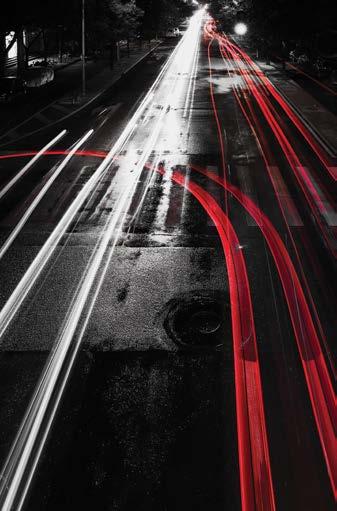

How can countries and cities attain their SDG targets and improve the sustainability of their transport sector? How can they prioritise action based on their performances on mobility and accelerate progress? These questions are at the heart of Global Roadmap of Action.
The report proposes a coherent menu of policy actions to reach the SDGs and achieve the four policy goals that define sustainable mobility (universal access, efficiency, safety and green transport). It embodies the collective knowledge of 55 organisations, 180 experts and more than 50 decision-makers including transport ministers, city mayors, public transport operators and 25 corporations.
Over 300 new mines for graphite, lithium, nickel and cobalt will need to be built over the next decade to meet NEV and energy storage battery demands.
- Manganese | South Africa [70% of the world’s manganese reserves], some in DRC and Gabon
- Cobalt | DRC [>60% of world supply, 85% is exported to China] and some from Zambia
- Lithium | Zimbabwe [5th largest producing country], some in South Africa and in Namibia
- Graphite | Mozambique [20-40%: global reserves], some in Tanzania, Zimbabwe, Madagascar
- Copper | South Africa, the DRC, Namibia, Zambia and Zimbabwe
Realising wide-scale adoption of EVs will require a substantial increase in the identification and responsible extraction of resources critical to the battery supply chain, as well as battery end-of-life policies that minimise environmental harm and support robust supply chains for battery materials.
Demand for NEV batteries will increase from what we have today to over 9 300GWh by 2030. This will apply tremendous pressure on existing supply chains for critical minerals, components and materials. For example, some estimates suggest that global demand for lithium from battery factories could hit three-million tons by 2030, requiring a massive increase over the 82 000 tons produced in 2020.
Benchmark Minerals Intelligence estimates that over 300 new mines for graphite, lithium, nickel and cobalt will need to be built over the next decade to meet NEV and energy storage battery demands. As a result of rising demand and tight supply chains, prices of raw materials such as cobalt, lithium and nickel will continue to surge. In May 2022, lithium prices were over seven times higher than at the start of 2021.
Fuel cell. In addition to battery and plug-in EVs, hydrogen fuel cell electric vehicles represent an important technology on the path to decarbonising road transportation. This is particularly important for heavy-duty vehicles, where battery technology may present challenges related to weight, cost, charging and range.
For fuel cell electric vehicles [FCEVs], hydrogen should be priced at affordable levels and hydrogen fuels made more conveniently available to users. Accordingly, government support measures are needed in the areas of fuel cell and hydrogen storage R&D as well as hydrogen production and station infrastructure development.
Grid reliability/Decarbonising. South Africa has major energy supply and security challenges. Realising the full potential of NEVs and their charging infrastructure will require careful evaluation of upgrades to the electricity grid infrastructure, as well as the transition to clean and renewable sources of energy. A critical factor in the wide-scale adoption of NEVs is ensuring the grid infrastructure is reliable, resilient, affordable and able to accommodate various charging needs (not limited only to light-duty vehicles).
We must work collaboratively to understand how widespread adoption of NEVs will increase demand on existing infrastructure and plan for the necessary investments required to maintain grid upgrades and reliability. Further, realising the benefits of electric and fuel cell vehicles makes decarbonising the electric grid increasingly important. To truly achieve the bold ambition of carbon neutrality, especially decarbonisation of road transport, the power used to charge EVs will need to come from clean and renewable sources, while also maintaining the reliability necessary to meet demand.
South Africa is betting big on so-called green hydrogen to both grow and decarbonise hard-to-abate sectors of the economy. Hydrogen is the lightest and most abundant element in the universe. It can serve as an alternative, emissions-free transport fuel when used to power fuel cells. Hydrogen is considered green when it is produced using renewable electricity to split water into hydrogen and oxygen using electrolysers. Fuel cells work by combining hydrogen and oxygen in an electrochemical process that generates electricity, with the only by-product being water.
While this prototype offers a glimpse into a low-emissions future for mobility, having this technology widely adopted for passenger vehicle use in South Africa requires a level of investment in renewable energy generation, as well as hydrogen production, storage, transportation and refueling sites that just do not exist at present.
FCEVs are also only recently emerging from the shadows of their more well-known counterparts: EVs and variants thereof. While perhaps the most desirable option, especially as petrol prices skyrocket, South Africans have limited options in this regard. The lack of local supply is particularly striking in the entry- and mid-level market segments, with most available models competing in the high-end to niche segments. Moreover, the majority of South Africa’s energy generation is powered by the carbon-intensive process of burning. Carbon emissions come from two major industries, of which energy production accounts for 34% of the emissions and manufacturing accounts for 24%.
South Africa’s rapid adaption is critical for the domestic automotive industry’s long-term success and growth. The only way

Sustainable Urban Mobility | Briefing paper | World Economic Forum | Global New Mobility Coalition | [May 2023]
By 2050, almost 70% of people will live in urban areas, with towns and cities expected to grow by 2.5-billion people over that period. In an increasingly urbanised world, delivering healthy and vibrant cities is vital for both people and planet. When it comes to achieving this vision for cities of the future, there is perhaps no sector more important than mobility. Transport is the lifeblood of cities. As cities grow and evolve, so must our transport systems.
Electrification needs to be accelerated in sync with a powerful push towards more connected public transport, improved infrastructure, priority for cycling and walking and integration of emerging mobility solutions such as shared mobility to create a suite of options to meet the wide-ranging needs of people moving about cities. It is only with a combination of these solutions that we can cut emissions to address the urgent climate emergency, reduce traffic on the road to make our streets safer, all while transporting a growing urban population.
No one city or one company can achieve this vision alone. Through strong public-private collaboration, we can find innovative, impactful and context-sensitive solutions for mobility to enable a sustainable future for cities. The Urban Mobility Scorecard Tool is testament to the power of public-private collaboration and is a resource that can help cities benchmark and accelerate progress on urban mobility.
A critical factor in the wide-scale adoption of NEVs is ensuring the grid infrastructure is reliable.
to have a successful automotive manufacturing base is to keep up with technological developments. The South African automotive industry cannot be running on one development technology track while the rest of the world is way ahead on the same track. Developed economies have a saturated vehicle demand and a replacement cycle that is heading towards BEVs.
The transition towards newer automotive technologies, such as NEVs, needs to be seamless because South Africa cannot afford to operate on two parallel technology tracks, manufacturing both old and new types of vehicles because it is already struggling to attain economies of scale. Our country needs to be on a progressive



path by manufacturing new technology vehicles which has a huge growth potential, rather than being on a path which is stagnant with older generation technology whose market is declining.
The South African and the broader regional market is non-dynamic, with only limited projected growth over the next decade. The growth in NEV sales in South Africa will therefore displace ICE sales, as opposed to generating additional aggregate sales in the market. South Africa needs to be able to compete for production contracts to supply markets that require new energy vehicle technology automotive manufacturers will need to be at the forefront of these new technologies to capitalise on the huge growth opportunities which exist.
This article is an excerpt from SOUTH AFRICA’s NEW ENERGY VEHICLE ROADMAP THOUGHT LEADERSHIP DISCUSSION DOCUMENT | The Route to the White Paper | The National Association of Automobile Manufacturers of South Africa (Naamsa) | [February 2023]


greeneconomy/report recycle
INVESTMENT AND
IN THE SOUTH AFRICAN TRANSPORT SECTOR | A FOCUS ON LOW-CARBON TECHNOLOGIES | Climate and sustainable investment | National Business Initiative | Just Share | WWF | The Lewis Foundation | [October 2022]
Despite over a decade of work on low-carbon transport by several parties in South Africa, the sector is only now beginning to receive serious attention. This report focuses primarily on providing assessments of technology risk for the transport sector transition and aims to support financial institutions’ risk evaluation methodologies with overviews of technology options and associated ESG risks in the transport sector.
NEVs currently cost significantly more to produce than equivalent gasoline cars or trucks.
Unless ambitious public policy action is taken, EVs will remain the privilege of the few for the foreseeable future. A dual strategy is necessary. It involves promoting the purchase of entrylevel EVs in the passenger car market while simultaneously fostering their introduction in public transport.
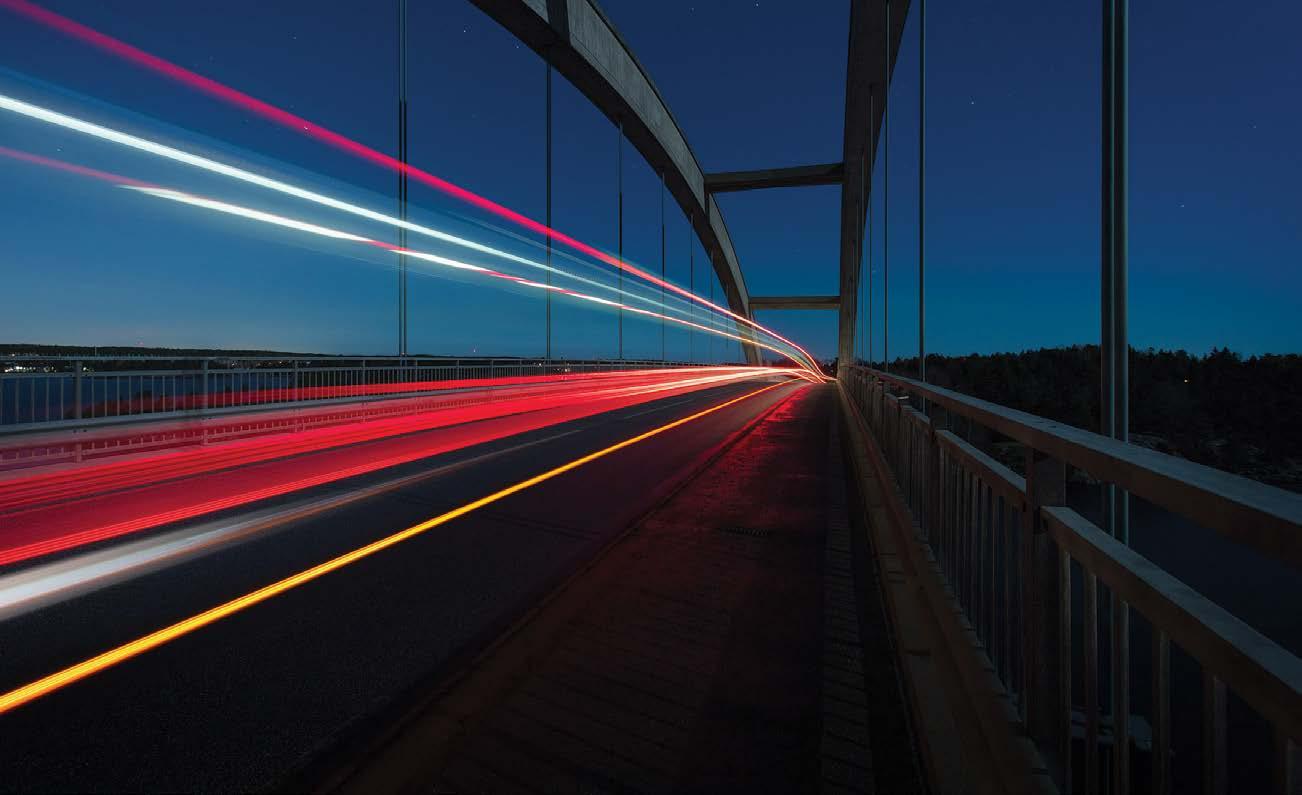 BY GAYLOR MONTMASSON-CLAIR*
BY GAYLOR MONTMASSON-CLAIR*
Ihave been working with partners to understand the implications of the global transition to e-mobility for South Africa. Our work also included the most appropriate interventions for the country to mitigate risks and maximise benefits. An exclusionary, elitist transition to e-mobility is one such risk. Yet, as explored in a recent Trade & Industrial Policy Strategies policy brief, an opportunity exists to shape the rollout more comprehensively in both private and public transport.
First, the dual strategy would involve promoting the purchase of entry-level passenger electric vehicles (EVs).
Many, from politicians and government officials to civil society activists and unionists, will object to this very idea. After all, why should the country support the sale of private vehicles? Merely a third of South African households own a car and only upper middleand high-income households would be able to afford an EV, even an entry-level model.
The same argument would also be expressed as: can’t we just let the market transition on its own?
The answer to this would be maybe, if South Africa did not have an automotive manufacturing industry or if vehicles produced domestically were all exported. But that’s not the case. South Africa has a well-developed automotive value chain, often heralded as the crown jewels of the country’s industrial policy. And the local industry is closely tied to both domestic and European dynamics.
The local market matters. It accounts for two out of five passenger vehicles manufactured in South Africa. Moreover, about half the market
for new vehicles consists of entry-level vehicles below R260 000. But EV sales are insignificant. There were only 6 367 of them on South African roads by the end of 2020. All EVs, including hybrid models, accounted for less than 0.2% of new car sales in 2020.
Yet, a transition to producing more EVs is vital if South Africa wants to keep up with developments in Europe. About three out of five passenger vehicles manufactured in South Africa are exported, primarily to Europe (three-quarters of exports). Europe accounted (in value) for 60% of South African exports of automotive vehicles and components in 2020.
And the European trajectory is clear: no internal combustion engine or hybrid sales by 2035 in most countries.
The cost of doing nothing would be disastrous for the sector – and South Africa’s environment.
Electric vehicles are cheaper to own. But they’re more expensive to buy than their internal combustion engine counterparts. This is a problem given that the domestic market is very price sensitive, particularly in the entry-level segment. Temporary support for the full range of EVs is recommended to incentivise prospective buyers. The support would need to bridge the gap between them and internal combustion engine equivalents in the entry-level segment.
Fostering EV sales domestically could be achieved through a direct, fixed-purchase subsidy and extremely low-interest loans, underpinned by development finance institutions for entry-level electric vehicles.
To minimise financial implications and keep up with global trends, strict conditions would be required. Most importantly, support should lapse in 2030 for soft hybrids and 2035 for all other EVs.

The availability of entry-level EVs on the local market is a fundamental precondition for the incentive to be effective. To this end, the tariff anomaly, which sees battery electric vehicles originating from the EU fetching a 25% tariff (against 18% for all other vehicles) should be resolved.
Second, it requires fostering the introduction of EVs in public transport. Close to three-quarter of South Africans relied on public transport as their main means of commuting in 2019. Of commuters that use public transport for their mobility, 66% used minibus taxis and 12% buses. So far, knowledge in deploying electric public transport vehicles is limited. Cape Town is the only municipality to have experimented with e-buses, with little success. The buses proved unsuitable for the city’s geography and the tender process was marred by allegations of irregularities.
Electric minibus taxis is another route worth taking. No experience for these exists, though a pilot is planned for Stellenbosch. The rollout of electric minibus taxis should be supported through a temporary, enhanced Taxi Recapitalisation Programme scrapping allowance for the purchase of EVs.
In addition, reducing the cost of finance for e-minibus taxis would further support the transition. Minibus taxis are considered high risk and face high interest rates when financed. Preferential financing terms of EVs could be achieved through government-guaranteed loans or the provision of concessional debt. This is also proposed for passenger vehicles.
For bus fleets, the rollout of EVs would essentially flow through public procurement programmes, such as bus rapid transport systems. Here, the public nature of the bus systems would allow
The Taxi Recapitalisation Programme is an intervention by government to bring about safe, effective, reliable, affordable and accessible taxi operations by introducing new taxi vehicles designed to undertake public transport functions in the taxi industry.
Pay As You Save® or PAYS is a proven financing approach that has been used in multiple countries to facilitate investment into a range of climate smart solutions. PAYS is now being used to reduce the upfront capital costs of transitioning from internal combustion engines to electric vehicles, starting with public transport.
for a great degree of experimentation with innovative mechanisms and models. This could involve grants as well as innovative financial arrangements and business models, like Pay As You Save®, battery leasing or bus sharing.
Complementary measures could also be introduced. These include adequate charging infrastructure, differentiated electricity tariffs (to encourage off-peak charging), preferential access/parking or discounted licenses. Besides being critical for South Africa’s industrial development, stimulating the local manufacturing of all types of EVs could also result in lower-cost vehicles in the long run.
More broadly, the “electric revolution” can make transportation more environmentally sustainable. It also provides a unique opportunity to make it more socially inclusive.
* Article written Gaylor Montmasson-Clair, Senior Economist, Trade & Industrial Policy Strategies (TIPS), University of Johannesburg. This article is an excerpt from POLICY BRIEF | TOWARDS AN INCLUSIVE ROLLOUT OF ELECTRIC VEHICLES IN SOUTH AFRICA | TIPS | [February 2022]

The cost of doing nothing would be disastrous for the sector.


Africa’s triple challenges of poverty, inequality and unemployment have created a unique backdrop for the way people move themselves and their things. Although gaining traction as a plausible solution to high carbon emissions and congestions in cities, micromobility is not new in Africa.
Mobility solutions across the African continent have been driven by purpose, the availability of infrastructure and the cost of acquisition and maintenance. It is no wonder that the most popular modes of mobility are those that are not only fit-for-purpose but also demonstrate unrivalled operational sustainability. This has little to no consideration of carbon emissions or the latest technology trends.
Demand responsiveness, where there is poor road infrastructure and dense urban settings, requires mobility solutions that are characterised by easy manoeuvrability. Thus, two-wheeler usage and densities are higher in African countries with constrained transport infrastructure development in both rural and urban settings. The evident lack of organised and sophisticated transport systems, regulation and law enforcement has significantly lowered barriers to entry in this market across Africa.
While South Africa has been lagging its counterparts, it is catching on very quickly. Its apartheid legacy spatial planning of urban and peri-urban (townships) contributed to very low adoption in the past few decades where there was assumed unsuitability of two-wheelers as a functional mode of transport for lower income groups. However, this has changed significantly in the past five years with the growth of the e-commerce market and need for faster last mile food delivery.
In the 1960s, Kenya, Tanzania, Burundi, Rwanda and Uganda saw the birth of the Boda Boda , a modified bicycle to transport people to and from borders for commercial purposes. Designed to carry weights of over 250km 1, these bicycles were and still are a modal choice for a fast journey over poor road infrastructure. The class A motorbike entered the East African market in the early 1980s after making headway in West Africa in the 1970s.
In South Africa, the apartheid transport policies, systems and spatial planning saw sophisticated public transport in white urban areas while those living in the periphery depended on government-controlled buses and trains to commute.
From 2000 to 2010, East and West Africa reported growth of up to 40%2 in their respective markets, further cementing the two-wheeler as a dominant mode of last mile commercial transport. Despite the challenges of regulation and policy inclusion, this mode continued to thrive, often referred to as the “necessary nuisance”.
Technology such as SafeBoda 3 sought opportunity in driving innovation in this informal mode of transport. However, post the Covid-19 pandemic this platform had to pull operations in both Nigeria and Kenya sighting challenges with sustainability of its operating model in those economic environments.
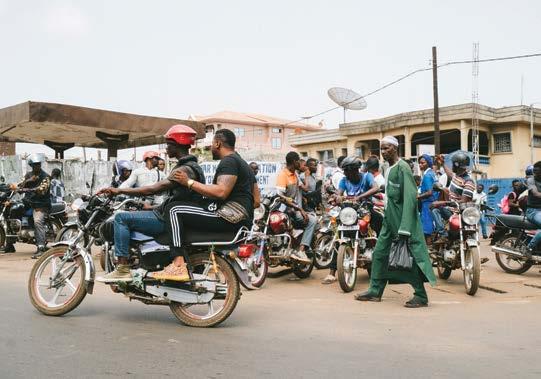
Market growth in southern Africa can be directly attributed to the emergence of last mile food delivery. Largely anchored on e-commerce platforms there is an undisputed dependency. As e-commerce grows in sub-Saharan Africa so does the two-wheeler market. The use of innovative platform technologies to manage, track and settle payments for operators are key characteristics. One can argue that while acceptance and adoption of the two-wheeler was slow over the past few decades perhaps the South African market’s growth will display a lot more sophistication and rapid growth of e-motorcycles compared to the rest of Africa.
The period between 1970 and 1980 saw rapid urbanisation and inadequate intracity mobility in both East and West Africa, which created a demand for readily available, cheap transportation means that could easily manoeuvre poor road infrastructure. An informal transportation market operated by the mostly unemployed boomed.
It is important to note that smaller more efficient modes of transport in the African context do not follow the traditional logic for transport planning. This is a known fact among transport practitioners in the continent. Informal mobility solutions often grow exponentially outside of the ambit of planning and regulation. Filling the gap for missed mobility needs, these solutions become a runaway train, where regulation chases.

Today with various conflicting reports, the market is an estimated USD3-billion and is expected to reach USD5-billion by 2027. These conflicting reports are due to a lack of concise data and informality in some of the largest markets within the continent. Nigeria is by far the largest market, in second place Egypt and surprisingly South Africa comes in at third place according to TechSci Research , 2022.
The African market is still dominated by combustion engines produced by Japanese brands such as Yamaha, Suzuki and Honda, followed closely by Indian brands, TVS and Bajaj 4. Chinese models have also gained some market share, although small.
The African e-commerce boom coupled with louder environmental concerns has created ground for rising demand in energy-efficient two-wheelers. From electric bicycles to e-motorcycles and e-scooters, market significance is growing. New manufacturers have entered this very competitive market as the continent is making a steady transition from combustion engines. However, according to PREO 5 , there are some major challenges:
1. Over 90% of two-wheelers available in the market are Chinese brands which are not built for the African environment.


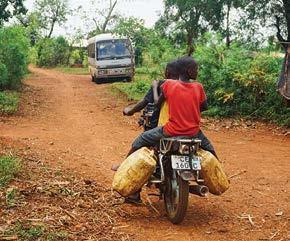

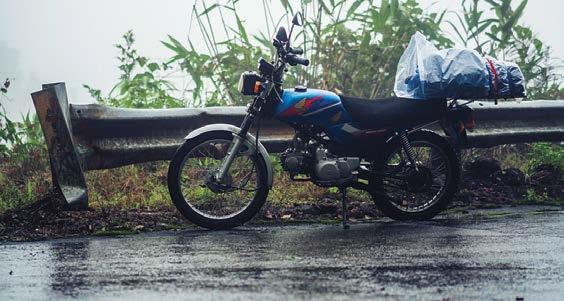

2. Access to electricity is estimated at 48%, which makes it impossible to fully support a stable charging network.
3. EVs are normally double the cost of combustion engines.
With a population of 1.3-billion, 60% of which is under the age of 25, Africa is still growing. Rapid urbanisation is a catalyst for efficient and affordable modes of transport as a service. Straddling the formal

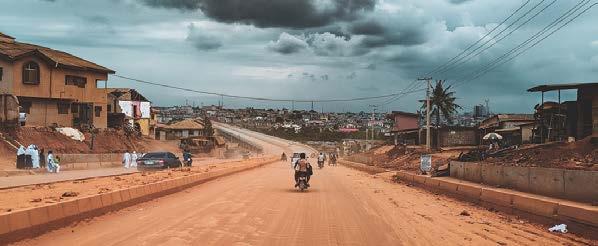

and informal economies, the African two-wheeler market is a critical fiscal contributor. Asset acquisition and running costs sit in the formal economy, with revenue generation in the informal economy. With many African countries battling the youth unemployment fiscal challenge, perhaps here lies the opportunity to create employment and drive innovation in this already thriving market.
Access to financing has always been a challenge for informal mobility providers across the globe. Some African governments have become creative, using policy instruments, incentives and investment towards the establishment of manufacturing industries. The attractiveness of incentives has contributed to exponential growth of the market in some East African countries. While these incentives drive prices down, they also reduce barriers to entry significantly. Countries like Kenya have introduced tax waivers on production localisation 6 and import taxes. These initiatives are targeted at growing robust manufacturing activity compared to importing the fully assembled two-wheelers and have resulted in Kenya growing its fleet from a mere 100 000 in 2007 to over 700 000. The price point for an entry-level combustion engine Class A two-wheeler has decreased from USD2 000 in the 1990s to as little as USD420 7, making it affordable for individual operators. Given the significant reduction in operational costs such as fuel, the energy- efficient two-wheeler should make for competitive pricing.
Creating an ecosystem that captures resources and capabilities of multiple players in the market is what creates sustainable and
efficient transport systems. Energy-efficient mobility is no different. No single entity (private or government-led) will be able to provide a self-sustaining market entirely alone. While government’s primary pivot is creating favourable policy conditions, entrepreneurs should focus on building a thriving industry and making sizeable investments towards manufacturing, infrastructure and battery solutions. According to PREO, this sustainability ecosystem has three critical tenants:
1. Efficient production of durable electric two-wheelers
Many emerging start-ups in southern Africa are reliant on complete knock-down (CKD) or fully assembled unit imports. East Africa has a thriving manufacture and assembly market, in which Kenya leads with over 20 entities. Growing local manufacture ensures customisation so that two-wheelers are built for the rough African terrain.
2. Reliable and dense charging infrastructure
Off-grid energy solutions that are publicly available have not gained momentum in Africa. Southern Africa has made some headway in diesel generator grid power, which is a less viable option given the unsustainable carbon emissions. Solar home systems are unaffordable and only provide a small fraction of the energy required. On-site solar PV is the more sustainable solution for scaling battery charging and swapping infrastructure for two-wheelers. The absence of extensive investment in this sector is the challenge.
3. High-quality batteries for low-volume African buyers
Large-volume global players enjoy the benefit of accessing quality batteries from Europe, while Africa contends with this barrier. Lowquality batteries do not provide the reliable range and performance thus operators will always gravitate towards ICE models.
Transitioning from combustion to electric is more complex in the African context. Socio-economic factors require a unique approach that is empathetic to current conditions and not driven by innovation.
While Africa battles its three most wicked challenges, pressure for the reduction of carbon emissions is becoming the fourth. Many solutions directed at African mobility fail before they take off, mainly because they do not consider the real needs of the people. Mobility solutions should be centred around people, thus should be fit-for-purpose. This is evident in how the two-wheeler or even the mini-bus taxi has become the backbone of most transport services in the African continent. Will an electric two-wheeler deliver the service a combustion engine provides in rural KwaZulu-Natal or the outskirts of Lagos? That’s but one of the questions transport planners should be asking.
Transport planning in Africa is synonymous with exclusionary results that further drive inequality. While innovation and technology should enhance efficiencies of existing mobility as a service solution, creating an entirely new market with new operators is not only disastrous but dangerous as well. One only needs to look at recent history when Uber entered the African market.
Adoption, or lack thereof, poor infrastructure, unsophisticated transport systems, informal markets with little to no regulation, spatial planning and urban densification, unreliable energy sources and scanty government funding are just some of the most wicked shortcomings of the African mobility context. An approach to solutions that are impactful should always be mindful of these. As Africa redefines and redesigns the way people move, perhaps the approach should be focused on creating efficiencies and innovation of what works for Africa.
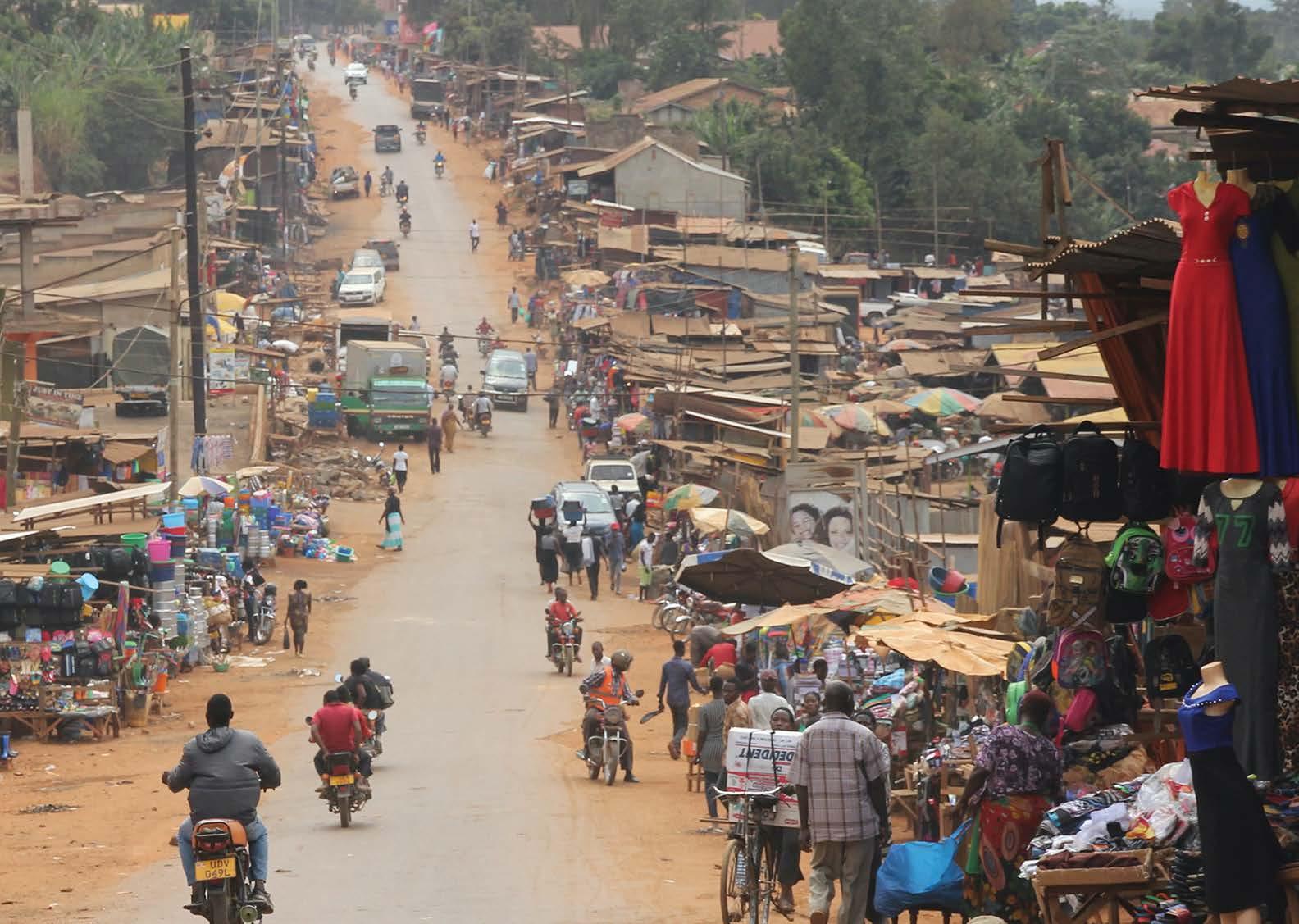
Many solutions directed at African mobility fail before they take off.
Globally automakers are embracing EVs, which means rapidly growing demand for raw materials in batteries. Supplies of graphite might seem plentiful, but heavy uptake for EVs creates a serious risk. Automakers and utilities need to work now to avoid unexpected shortages or price shocks.
BY KEARNEY CONSULTINGThe US Geological Survey has classified five battery materials as vital elements due to the risk of supply disruptions from burgeoning demand. Three of these – lithium, nickel and cobalt –get most of the attention because they typically form the cathode that decides the capacity and power of the battery. A fourth mineral, manganese, helps to make up a secondary option for cathodes (lithium-manganese oxide), and can therefore be replaced if other elements are available; it also has 10 times the global production of the other minerals. (The other substantial raw materials in batteries are the commodities of aluminium, iron and phosphate with no likelihood of shortages.)
Graphite, by contrast, is the most common base for the anode, far superior to current alternatives. It may be secondary, yet it is crucial for releasing electrons from the cathode to the external circuit. That’s because graphite is both stiff and highly conductive, and its layered chemical structure enables it to store electrical charges better than other materials. Nearly all anodes, whether for lithium-ion or the main alternative batteries, rely heavily on graphite. This is true for stationary batteries as well as storage in cars.

Graphite is the largest single unit of batteries, and electric cars typically include 50 to 100 kilograms of the mineral. Graphite made up 2% of the battery cost in 2022 prices (28% for weight); the corresponding figures for lithium are 21% and 3%. Chargers for most electric vehicle (EV) batteries also rely heavily on graphite as a component. (Besides the cathode and anode, EV batteries consist of electrolyte and separators, neither of which involve scarce minerals.)
Recent articles on EV supply worries have focused on lithium, nickel and cobalt, with little if any mention of graphite. After all, graphite seems plentiful, with a well-developed supply chain due
to longstanding demand, especially in steelmaking, electronics and electric power generation. Current graphite prices are roughly onetenth that of lithium.
An analysis of expected demand by Benchmark Mineral Intelligence suggests that graphite has the largest future gap between supply and demand – even more than that of lithium, long seen as the bottleneck with prices that tripled last year. Graphite demand is likely to grow by a factor of eight by 2030 over 2020 levels (4.2 metric tons over a supply of 3.0) and 25 times by 2040. That translates into a predicted supply shortfall of 30% for graphite, compared to 11% for lithium (2.4 over 2.1), 26% for nickel (1.5 over 1.1) and 6% for cobalt (0.32 over 0.30). Note that battery makers need three times as much natural graphite to make one unit for graphite anodes, higher than for the other minerals.
These are rough estimates, and the recent decline in lithium prices cautions us against straight-line extrapolation. Nevertheless, the gap serves as a warning to all consumers of graphite to plan for contingencies. By 2030, graphite supplies will likely not cover all demand. Industrial consumers will need to find alternative sources, expect shortages or pay higher prices. Semiconductor and other shortages in the recent Covid pandemic can serve as a vivid reminder of the disruption caused by difficulties in crucial supply chains.
Commentators see little reason to worry about graphite supplies. After all, the current supply is plentiful, with many mines around the world, some operating below capacity. The owners of capital-intensive mines are unlikely to cut back production, and geologists have found accessible graphite deposits in much of the world. Metals producers
have succeeded in synthesising graphite from abundant petroleum, and the resulting supply now makes up half of worldwide demand.
These dynamics apply to nickel, cobalt and manganese, especially because they are largely interchangeable in combining with lithium to form cathodes. But no mineral works as well as graphite in anodes, whether with lithium-ion or the leading alternatives. So, graphite, even more than lithium, is hard to replace.
Graphite seems a plentiful resource overall. But the rapid increase in demand just for EVs is likely to absorb all available demand by 2030. Graphite suppliers won’t be able to keep up, even as they shift from steel makers to electric vehicle battery makers as their main customer (see figure 1).

Meanwhile synthetic graphite comes with its own problems. It currently costs double the price of the natural, mined version, and refineries for synthesising graphite can take as long to set up as a graphite mine. And even if natural graphite doubled in price, synthesising the substance draws on fossil-fuel byproducts and generates far more pollutants than the natural version.
While most EV batteries currently do rely on synthetic graphite, US EV makers are showing a preference for mined supplies – especially as processors have improved the resulting purity. High-purity natural graphite is also making headway into semiconductors and nuclear power generation. And if fossil-fuel refining does fall because of the shift to EVs and renewable energy sources, synthetic graphite ironically will become more expensive. As a result, natural graphite production is likely to outpace synthetic yields by 2030.
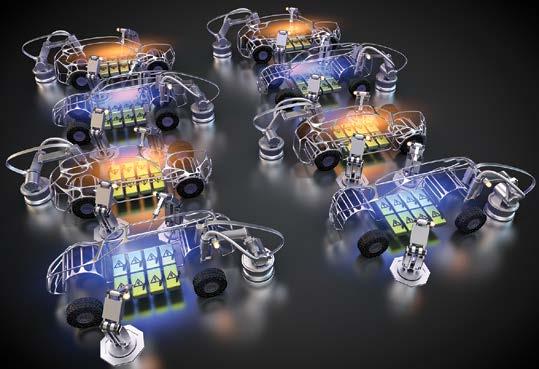

As for those abundant graphite mines, the largest are in China, which produces three-quarters of the world’s annual supply of the natural version. Yet the Chinese government could decide to restrict sales to the West, even if the mine owners would like to keep selling. In a recent letter to shareholders, JP Morgan Chase CEO Jamie Dimon pointed out that “China, using subsidies and its economic muscle to dominate batteries, rare earths, semiconductors or EVs could eventually imperil national security by disrupting our access to these products and materials.”
As for mines opening elsewhere, most of these are in Africa and Latin America where weak governments bring other problems. The US has no substantial deposits of natural graphite. It also takes a long time to start up a mine, so the supply is less responsive than executives may think.
Complicating all of these analyses is that graphite comes in various forms according to the demands of customers. EV batteries, for example, use the spherical-coated form, while semiconductors need highly purified graphite. Some mines yield only one kind. But overall, the future is difficult for graphite customers that expect a largely unchanged supply and price for the commodity.


A few manufacturers are already starting to de-risk their graphite supplies, but there’s no easy solution. Let’s start with the basic question of preference: natural or synthetic. If, like most EV companies, you prefer natural, then you need to start with figure 2 (on next page), which shows the total reserves of deposits vs annual production of the major suppliers for 2021.
Nearly all anodes, whether for lithium-ion or the main alternative batteries, rely heavily on graphite.Graphite ore. Background: Graphene structure. Kearney Analysis
Chargers for most EV batteries also rely heavily on graphite as a component.Figure 1. EV demand will absorb all graphite output at current rate.
In the medium to long term, customers can build relationships with suppliers in Turkey and Brazil. Existing mines there may already have locked up their production, but the two countries hold enormous reserves and are likely to expand production soon.
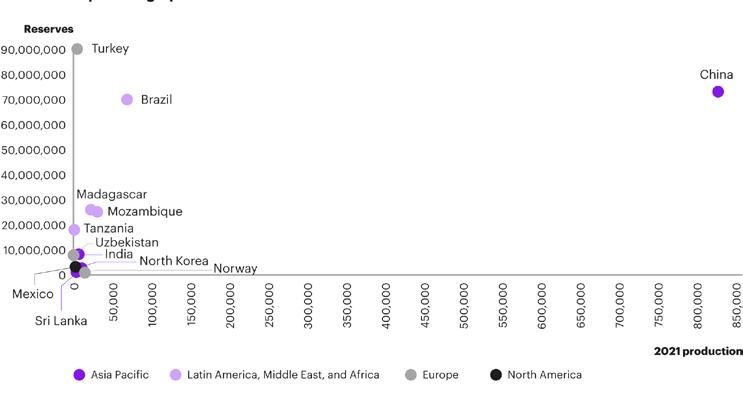
As for supplies of synthetic graphite, the challenge here is the processing of those fossil-fuel by-products. US production is likely to fall due to strict environmental regulations and costs. Beyond the immediate sourcing, companies have a variety of options for reducing risk in graphite supplies:



Long-term contracts. Tesla has extensive formal agreements with Syrah in Australia to buy graphite from mines in Mozambique. GM has a six-year agreement with Posco (a South Korean steel maker) to supply synthetic graphite.
Demand reduction. BMW is pioneering technology to reduce the graphite content in batteries (silicon is the best alternative).
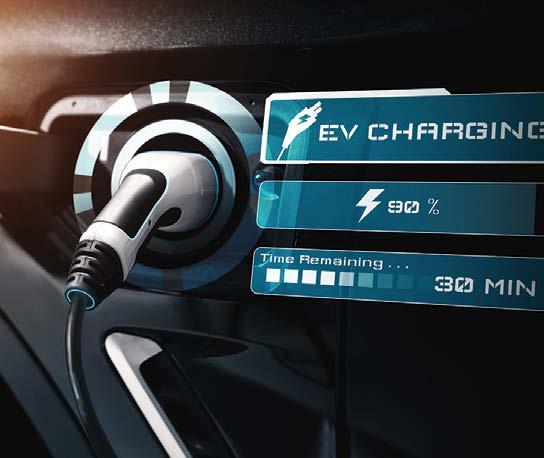
Near-shoring. To reduce political risk, Tesla is evaluating mineral resources from Canada. Hyundai is likewise evaluating localisation to
ensure a stable supply. These are mid- to long-term approaches, not quite fixes. Building on these approaches, we recommend multiple initiatives across both the short and long term:
Seek long-term contracts with a broad mix of suppliers. Longterm contracts will ensure a steady supply even if the market is squeezed tight and could work with either commodity aggregators or with mines/processors directly. The optimum mix includes two to three established suppliers and two to three recent entrants as challengers. Because these are commitments over several years, buyers will need to predict their own needs for graphite as well as assess the supplier’s plans for expansion. They should also segment suppliers based on their political risk profile and geography. Vertically integrated suppliers will need extra attention because some of their mines may be closing soon.
Form strategic partnerships across the value chain. Some large buyers may want to go further and create formal partnerships with suppliers, especially at nodes with constraints. Outright acquisition and vertical integration have become popular options but bring risk as well from greater corporate complexity and lost flexibility in a volatile market.
Reduce internal specifications and demand. Some battery makers have highly specific requirements for their graphite, both types and grades. Maybe they needed these specifications early, but now they should consider reducing these specifications to expand the potential suppliers. (Fewer specifications also helps to reduce internal complexity.) With recent advances in purification, they can also evaluate using both synthetic and natural graphite. Watch developments in graphite recycling. Researchers and start-ups have made breakthrough innovations in recycling used EV batteries, and graphite reuse may soon be practical. Large graphite customers should follow these developments and consider investing in feasible ideas to stay ahead of the curve.
Monitor sub-tier risks. The graphite value chain is complex, and disruptions in flows to a primary supplier can upset ambitious plans for batteries. Those depending on a steady flow of graphite can work in advance to identify and mitigate risk in the supply base. The Covid pandemic showed how disruptions in semiconductors could hobble most of the automobile industry. If EV batteries, as expected, become crucial to the future of transportation, then carmakers will need to expand their risk management to graphite suppliers –from natural disasters and labour unrest to geopolitical instability. EV battery makers and their automaker customers, have long realised the potential for supply bottlenecks for crucial battery minerals. Yet graphite, because of its seemingly secondary role in batteries and its large existing supply base, has attracted less attention than its supply risks warrant. As EV production takes off in this decade, customers in related industries will discover unexpected shortages and price jumps. The time is now to reduce those risks with attention to internal needs and external developments.
The most likely short-term sources are the mines opening in Mozambique, Madagascar and other African countries. These mines are looking for contracts, but procurement needs to factor in the frequent phases of political instability those countries have shown.
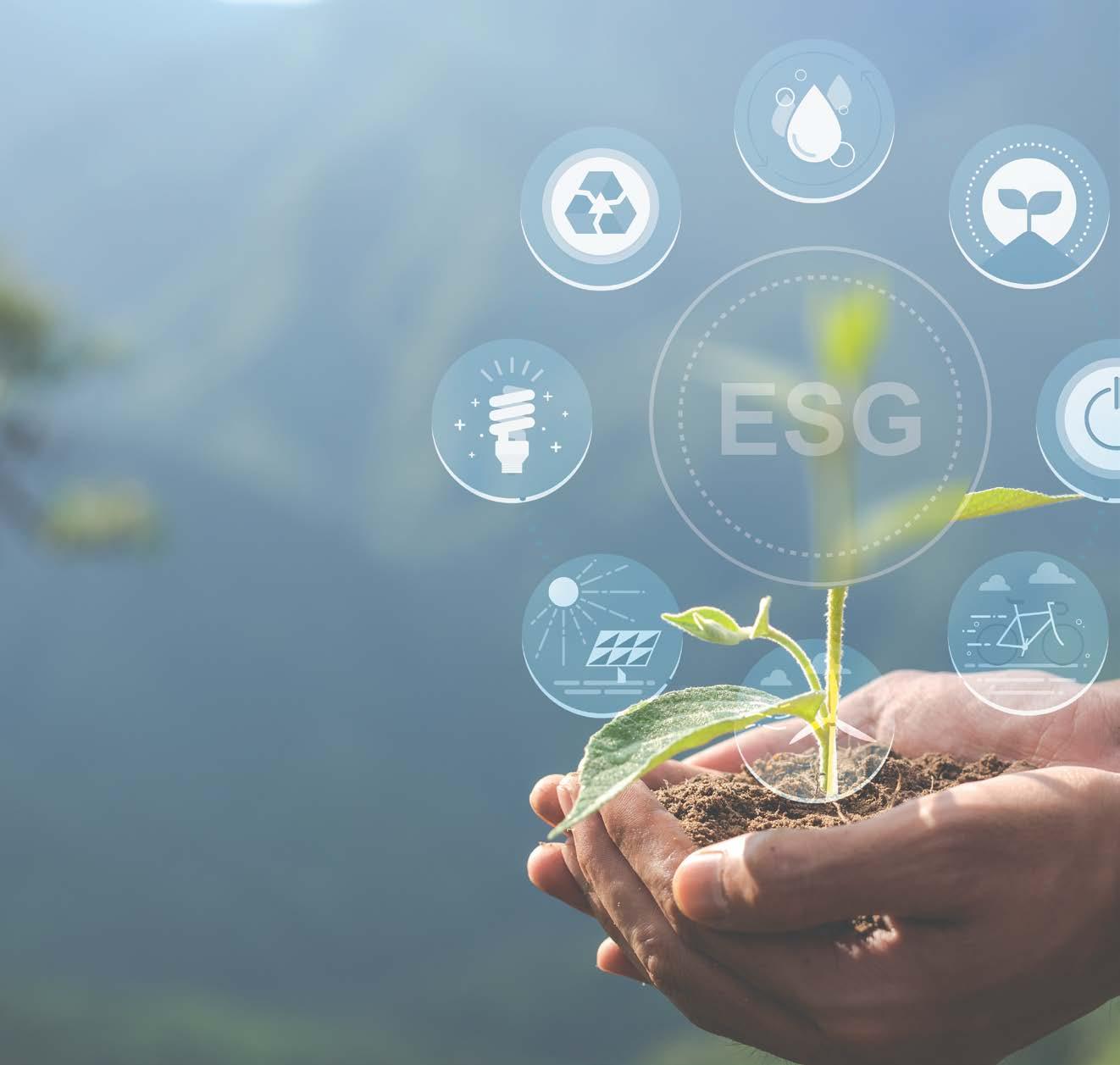


Singapore is generally considered to be the last remaining functional city-state in the world, with full sovereignty, international borders, its own currency, a robust military and substantial international influence in its own right. 1
 BY LLEWELLYN VAN WYK, B. ARCH; MSC (APPLIED), URBAN ANALYST
BY LLEWELLYN VAN WYK, B. ARCH; MSC (APPLIED), URBAN ANALYST
The Republic of Singapore, as it is officially known, is an island country and city-state in Southeast Asia, bordering Malaysia to the north. The World Bank (2021) states Singapore’s population as 5.45-million people who live and work within 733.2 square kilometres making Singapore the third most densely populated country in the world after Monaco and ahead of Hong Kong.2, 3 Despite this density there are numerous green and recreational spaces as a direct result of urban planning interventions. As such, Singapore is one of the greenest cities in the world, with parks and gardens occupying 47% of all land, compared to the 14% of New York and the 29% of Rio de Janeiro.4

The country’s territory comprises one main island, 63 satellite islands and islets, and one outlying islet; the combined area of these has increased by 25% since the country’s independence as a result of extensive land reclamation projects.
It is a major aviation, financial and maritime shipping hub serving some of the busiest sea and air trade routes. Changi Airport is an aviation centre for Southeast Asia and hosts a network of over 100 airlines connecting Singapore to some 300 cities in about 70 countries and territories worldwide. It has been rated one of the best international airports by international travel magazines,
including being rated as the world’s best airport for the first time in 2006 by Skytrax, and again in 2023.5

Singapore Changi Airport also had the second- and third-busiest international air routes in the world; the Jakarta-Singapore airport pair had 4.8-million passengers carried in 2018, while the SingaporeKuala Lumpur airport pair had 4.5-million passengers carried in 2018, both trailing only behind Hong Kong-Taipei (6.5-million).
The Port of Singapore, managed by operators PSA International and Jurong Port, was the world’s second-busiest port in 2019 in terms of shipping tonnage handled, at 2.85-billion gross tons (GT), and in terms of containerised traffic, at 37.2-million twenty-foot equivalent units (TEUs). 6 It is also the world’s second busiest, behind Shanghai, in terms of cargo tonnage with 626-million tons handled. In addition, the port is the world’s busiest for transshipment traffic and the biggest ship refuelling centre. 7
With its growth based on international trade and economic globalisation, Singapore has integrated itself with the world economy through free trade with minimal-to-no trade barriers or tariffs, export-oriented industrialisation, and the large accumulation of received foreign direct investments, foreign-exchange reserves and assets held by sovereign wealth funds.
As a highly-developed country, it has the third-highest GDP per capita (PPP) in the world. Identified as a tax haven, Singapore is the only country in Asia with an AAA sovereign credit rating from all major rating agencies.
More importantly, Singapore ranks highly in key social indicators: education, healthcare, quality of life, personal safety, infrastructure and housing, with a home-ownership rate of 88%. Singaporeans enjoy one of the longest life expectancies, fastest Internet connection speeds, lowest infant mortality rates and lowest levels of corruption in the world.8

Due to its limited land area certain infrastructure services are particularly challenging.
The hypothesis for the success of infrastructure development in Singapore is that its success is directly attributable to its city-state status. A city-state is an independent sovereign city which serves as the centre of political, economic and cultural life over its contiguous territory. 9 They have existed in many parts of the world since the dawn of history, including ancient poleis such as Athens, Jerusalem and Rome, as well as the Italian city-states of the Middle Ages and the Renaissance, such as Florence, Venice, Genoa and Milan.
Infrastructure is the set of facilities and systems that serve a country, city or other area, 10 and encompasses the services and facilities necessary for its economy, households and firms to function. 11 Infrastructure is composed of public and private physical structures such as roads, railways, bridges, tunnels, water supply, sewers, electrical grids and telecommunications (including Internet connectivity and broadband access).
In general, infrastructure has been defined as “the physical components of interrelated systems providing commodities and services essential to enable, sustain, or enhance societal living conditions and maintain the surrounding environment”. 12
With the rise of nation states worldwide there is some disagreement as to the number of modern city-states that still exist; Singapore, Monaco and Vatican City are the candidates most identified. The Economist called Singapore the “world’s only fully functional city-state”.

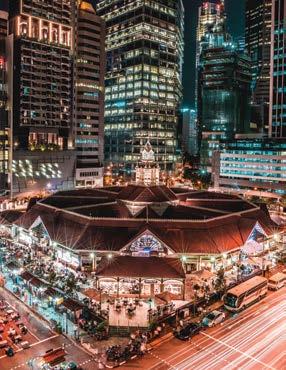

Considering the massive societal transformations needed to mitigate and adapt to climate change, contemporary infrastructure conversations frequently focus on sustainable development and green infrastructure. Acknowledging this importance, the international community has created policy focused on sustainable
infrastructure through the SDGs, especially SDG9, “Industry, Innovation and Infrastructure”.
One way to describe different types of infrastructure is to classify them as two distinct kinds: hard and soft infrastructure. 13 Hard infrastructure is the tangible, physical networks that support the wellbeing of communities. This includes roads, bridges, and railways. Soft infrastructure is all the institutions providing services that maintain the economic, health, social, environmental and cultural standards of a country. This includes educational programs, parks and recreational facilities, law enforcement agencies and emergency services.
Gross fixed capital formation is a termed used to measure investment in land, plant and equipment improvements, as well as the construction of infrastructure. Essentially it is a measurement of how much of the nation’s gross domestic product (GDP) gets invested in capital formation. It is difficult to extract the infrastructure investment spend from GCFC since GCFC inventory contains items that may be used in capital formation but not remain part of infrastructure. Therefore, one has to look at infrastructure spend as a percentage of GDP. In 2021, China was the biggest investor on inland transport infrastructure at 4.8%, compared to the US at 0.5%, with Singapore and New Zealand at 0.6%. 14
Due to its limited land area certain infrastructure services are particularly challenging. Water is one of those, with transportation another. In 2016 Singapore invested around 5% of its GDP on infrastructure. In 2023 it was 4% and is expected to rise to about 4.4% by FY2026 to FY 2030. 15
Water supply and sanitation in Singapore are intricately linked to the historical development of Singapore. Access to water in Singapore is universal, affordable, efficient and of high quality. As of 2017, there were about 5 500 km of potable water pipes in Singapore.
Innovative hydraulic engineering and integrated water management approaches such as the reuse of reclaimed water, the establishment of protected areas in urban rainwater catchments and the use of estuaries as freshwater reservoirs have been introduced along with seawater desalination to reduce the country’s dependence on untreated imported water.16 Five desalination plants have been opened throughout the country since 2003, which in total are able to produce a maximum capacity of approximately 890 000 000m3 per day.
Singapore considers water a national security issue and the government has sought to emphasise conservation. Water access is universal and of high quality, though the country is projected to face significant water-stress by 2040. To circumvent this, the Public Utilities Board has implemented the “four national taps” strategy – water imported from neighbouring Malaysia, urban rainwater catchments, reclaimed water (NEWater) and seawater desalination.
More critically, Singapore’s approach does not rely only on physical infrastructure; it also emphasises proper legislation and enforcement, water pricing and public education as well as research and development.
Singapore has declared that it will be water self-sufficient by the time its 1961 long-term water supply agreement with Malaysia expires in 2061. However, according to official forecasts, water demand in Singapore is expected to double from 1.4-million cubic metres to 2.8-million cubic metres per day between 2010 and 2060. The increase is expected to come primarily from non-domestic water use, which accounted for 55% of water demand in 2010 and is expected to account for 70% of demand in 2060. By that time, water demand is expected to be met by reclaimed water (50%) and by desalination accounting (30%), compared to only 20% supplied by internal catchments.
Singapore considers water a national security issue.
Road infrastructure

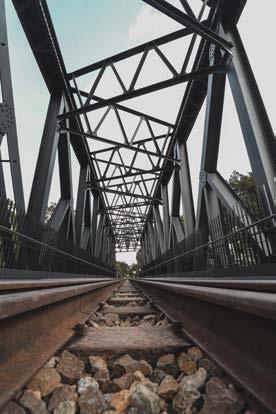


Singapore has a road system covering 3 356 kilometres, which includes 161 kilometres of expressways.17 Roads take up 12% of the country’s total land area. As Singapore is a small island with a high population density, the number of private cars on the road is restricted with a pre-set car population quota, to curb pollution and congestion.

Singapore’s car ownership rate is roughly 11%, whereas in the US it is nearly 80% and under 50% in Europe. In Singapore, car buyers must pay for Additional Registration Fees duties of either 100%, 140%, 180% or 220% of the vehicle’s Open Market Value and bid for a Singaporean Certificate of Entitlement (that varies twice a month in supply based on the number of car registrations and de-registrations), which allows the car to be driven on the road for maximum period of 10 years. Car prices are generally significantly higher in Singapore than in other English-speaking countries. According to the Land Transport Authority the total vehicle population of Singapore in 2021 was 988 755 of which 532 204 were private passenger cars.

Singapore’s public transport network comprises trains (consisting of the MRT and LRT systems), buses and taxis. Taxis are a popular form of transport as the fares are relatively affordable when compared to many other developed countries, while private cars in Singapore are the most expensive to own worldwide.
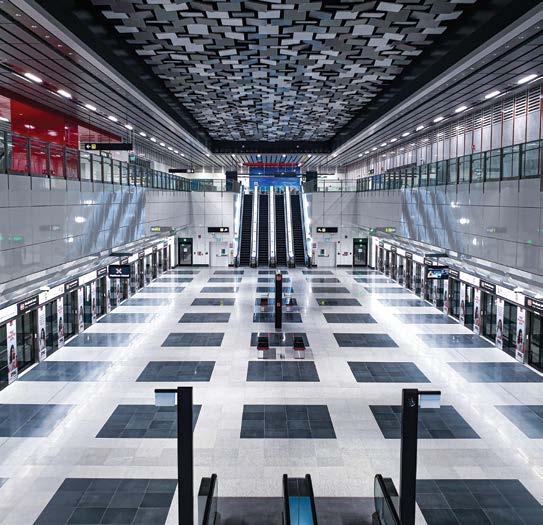
The city of Singapore is situated in the southern portion of the main island. Over time, urbanisation has blurred the differences between city and country. Built-up areas now cover a large part of the city-state. The older parts of the city have been substantially refurbished, especially along the Singapore River but elsewhere as well. The government’s Housing and Development Board (HDB) has relocated commerce into separate districts and has created integrated residential communities inhabited by people with a mixture of incomes. About four-fifths of Singapore’s population now resides in high-rise HDB flats located in housing estates and new towns. The new towns – such as Woodlands, Tampines and Yishun – are scattered across the island and are characterised by easy access to places of employment and shopping districts.



1) The compact geography of the island has forced a compact urban environment, which has resulted in reducing the overall extent of the infrastructure network.
2) The compactness of the city has enabled effective infrastructure services to be delivered.

3) Infrastructure effectiveness has improved community wellbeing.
4) More critically, Singapore’s approach does not rely only on physical infrastructure; it also emphasises proper legislation and enforcement, pricing and public education as well as research and development.
5) Singapore has embraced innovative engineering and integrated management approaches to improve efficiency and effectiveness.
6) The Singapore government has been prepared to make the hard choices regarding what type of infrastructure it is willing to invest in, and where. One of these is the restriction on private light vehicle ownership. Reducing private vehicle ownership has had a knock-on effect with regard to road construction, maintenance, land area and associated services such as parking and traffic management.
7) In exchange for the restriction on private vehicle ownership, it has provided excellent public transport.
8) Singapore has been very strategic in its approach to new urban developments, targeting integrated residential communities inhabited by people with a mixture of incomes. The new towns are characterised by easy access to places of employment and shopping districts.
1 Brimelow, Ben, 2018. How a tiny city-state became a military powerhouse with the best air force and navy in Southeast Asia. Business Insider. Archived from the original on 8 April 2018. Retrieved: 11 July 2023
2 Department of Statistics, Singapore, 2019. Environment. Department Statistics Singapore


3 Global Data 2021. Largest Countries in the World by Population Density in 2021 (People per Square Kilometres)
4 Gan, V. 2015. The link between green space and well-being isn’t as simple as we thought. In: Bloomberg
5 Skytrax 2023. Airport of the year winner history
6 MPA 2023. Singapore’s 2019 Maritime Performance
7 Sharanya, P. 2020. Singapore port container throughput hits record high in 2019. The Business Times, 13 January 2020
8 World Bank, 2022. Country Data: Singapore
9 Encyclopaedia Britannica, 2018. City-state | Definition, History & Facts. Encyclopaedia Britannica. Archived from the original on 23 November 2018. Retrieved 12 July 2023
10 Infrastructure | Define Infrastructure at Dictionary.com Archived 2016-03-05 at the Wayback Machine
11 O’Sullivan, A., and Sheffrin, S., 2003. Economics: Principles in Action. Upper Saddle River, NJ: Pearson Prentice Hall. p. 474. ISBN 978-0-13-063085-8
12 Fulmer, J. 2009. What in the world is infrastructure?. PEI Infrastructure Investor (July/August): 30-32
13 Investopedia, 2023. Infrastructure: Definition, Meaning, and Examples
Compactness and strategic investment decision-making are key factors in Singapore’s success. This raises further issues that need to be investigated with regard to the original proposition. One of these is the compact city, and the other is the use of innovative engineering and integrated management approaches. The latter speaks to microgrids and distributed grids.
14 Statista, 2021. Global investment on inland transport infrastructure as share of GDP in 2021, by selected countries
In the next issue these two factors will be further explored.
15 Han, G. 2023. Govt spending may hit 20% of GDP by FY2030, GST hike and tax moves were needed to fund growing needs: MOF.” The Straits Times, 9 July 2023
16 Ministry of Sustainability and the Environment, 2023. Our water policy in a nutshell
The consensus is that the higher the investment in infrastructure the higher the economic growth. However, as alluded to in previous articles, I have yet to see how much economic growth is delivered by higher infrastructure investment, and how that investment is to be sustained when the economy weakens as it does cyclically. Ordinarily, governments are able to reduce their infrastructure investment spending in economic downcycles, but that shouldn’t alleviate the maintenance spending associated with previous investment commitments, although it does, resulting in deteriorating infrastructure assets.
17 Land Transport Authority, 2023. Tracing our steps












Since our sustainability journey began, we’ve been leading the way, writing our planet-friendly story one industry rst at a time. From becoming the rst cement manufacturer in Southern Africa to publish an environmental policy, to modifying our plants to emit lower CO2 emissions, to introducing a range of green cement as early as 2000, putting sustainability rst has been, and always will be, second nature to us.









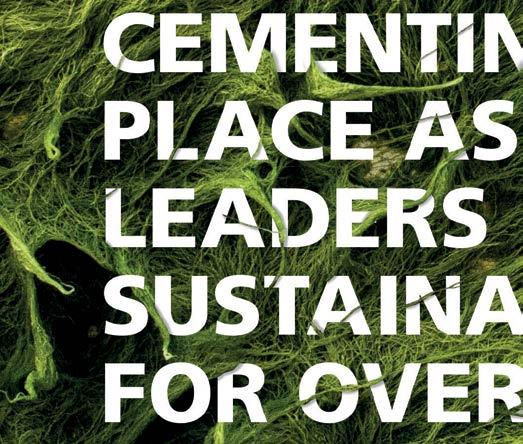
Mainstreaming a lifecycle approach to infrastructure project management is key. First and foremost, governments must follow good investment planning processes that prioritise projects based on development needs, socio-economic return and targeted to ensure inclusivity. There must be thorough understanding of associated commercial, technical, environmental, social and financial risks and their implications. Here, we need clear, practical guidance for decision-makers focused on real, lifelong affordability and value for money. All these conditions fit the public-private partnership (PPP) model well since lifecycle costing, risk-sharing and value for money are intrinsic to it.
Integrating the potential impact of climate change in infrastructure project design and structure in a manner that enhances value for money is also critical. The main challenge to climate change adaptation and mitigation of its potential impact on infrastructure is its integration into the project design and structure in a manner that enhances long-term affordability. This means looking at the long-term benefits of sustainability given the inherent uncertainties that could affect these assets over time. Here too, the very nature of PPPs makes them a strong tool to meet these challenges.
A PPP is a performance-based instrument, accustomed to the concept of long-term value for money, focusing on continued quality service rather than simply the underlying assets. With clear, contractually bound key performance indicators, PPPs are

well-placed to incentivise adaptation and mitigation to climate change and resilience in project design and service delivery based on private sector skills, technology and innovation.
PPPs could respond even better to current trends and challenges by introducing more flexibility in terms of models and contractual provisions, while including fiscally sustainable government support mechanisms to address resilience and affordability issues:
• Even with innovative private-sector approaches, climate change resilience and other future shocks will still require backing from the public sector to manage all the risks associated with long-term infrastructure projects. Government support mechanisms will facilitate reaching the most adequate risk allocation among parties that maximises value for money, ensuring both resilience and affordability. Instead of a principal-agent relationship, PPPs should create a framework and process for the joint discovery of innovative solutions for infrastructure delivery.
• Proper understanding of the fiscal implications of PPPs and their adequate integration in the overall public investment strategy prevent misconceptions that perceive PPPs as “free” infrastructure. This will help the above-mentioned government support mechanisms to be seen, not as an additional cost, but rather as tools to create the optimal structure to deliver quality infrastructure services.
Governments and public budgets are strained from Covid-19 recovery efforts, making it difficult to address climate risks and meet the goals of the Paris Agreement. Private sector participation is crucial to bridging the funding gap and advancing sustainable infrastructure development.
PPPs are one way to bring in private investment to infrastructure in developing countries. They offer a well-informed and balanced risk allocation between public and private stakeholders, provide long-term visibility and stability through contractual agreements and compensate for climate change uncertainty by offering contractual predictability.

The toolkits provide a set of practical tools to integrate climate mitigation and adaptation into PPP advisory work and project structuring.

Private participation and PPPs help bridge financing gaps while delivering sustainable infrastructure in developing economies – stimulating economic recovery. But how can PPPs be the “right tool” to support sustainable and resilient infrastructure development?
In the context of long-term PPP contracts, we need adjustments that add a certain degree of flexibility. Governments and practitioners need to embrace a more diverse pool of PPP models, including the better understood contractual PPPs, but also additional forms of institutional PPPs – for example, joint venture-type schemes. The challenge is to be aware of different options and wisely apply the best fit for the purpose. Since fully complete contracts that predict all potentialities are unattainable, contracts should instead put in place processes that foster satisfactory resolution of unforeseeable circumstances while increasing flexibility.
There is no single, internationally accepted definition of public-private partnerships (PPPs). The Reference Guide takes a broad view of what a PPP is, defining it as:





A long-term contract between a private party and a government entity, for providing a public asset or service, in which the private party bears significant risk and management responsibility and remuneration is linked to performance.

Practitioners can, if their projects are well-selected and their PPPs carefully structured, design and implement projects that optimise cost-effectiveness and social wellbeing by aligning private partner profit objectives with public sector service objectives that support the public interest.
A substantial body of knowledge on PPPs has been generated across the world by a broad spectrum of practitioners from government, the private sector, international development institutions, academia and expert advisors. This guide helps readers navigate this body of knowledge. It introduces key topics on PPP, sets out options and directs readers to examples and references where they can learn more.

The report proposes a concrete, stepped approach for governments to address barriers to private investment in adaptation and resilience, so private capital can actively contribute to financing national and local priorities. It provides guidance and a draft engagement plan for governments to create an enabling environment as well as business models for private sector investment in adaptation and resilience.
A coordinated approach to developing, financing and executing priority adaptation investments, driven by countries’ goals and national investment plans, can help accelerate and scale up private investment to meet the needs of climate-vulnerable communities and economies. The public sector – government agencies, policy makers, bilateral and multilateral development finance institutions, public sector funds and development organisations – thus plays a critical role in mobilising private investment.
ACTOM celebrates its 120th anniversary this year. Please provide an overview of the company.
ACTOM is the largest manufacturer, repairer and distributor of electro-mechanical equipment in the Sub-Saharan region, serving the energy, general industry and mining sectors. Our primary focus is supplying, repairing, and maintaining an extensive range of electro-mechanical equipment in Southern Africa.
Our journey began when British General Electric entered the South African market 120 years ago, laying the foundation for what would become ACTOM. Throughout the years, our ownership has evolved, and we were previously known as ALSTOM when GCE ALSTOM entered the country. However, around 2008, as GCE ALSTOM sought to leave South Africa, we transformed into a private equity firm with the support of investors such as the Old Mutual Trust. This transition allowed us to continue our commitment to innovation in the field of electro-mechanical equipment.
Please outline the energy sectors that ACTOM caters to. We manufacture a wide range of equipment, including boilers and motors used for power generation and we take pride in being one of the largest manufacturers of high-voltage equipment, particularly for the transmission network. In the distribution sector, we are actively involved in manufacturing and providing repair services for transformers. In the renewable energy domain, we focus on supplying the balance of plant equipment that connects to the grid. This includes a comprehensive range of solutions, from switchgear to protection and control schemes, as well as distribution transformers and high-voltage isolators and disconnectors required for transmission network connection.
ACTOM believes that African manufacturers can play a role in addressing the energy crisis. How so?
Our confidence in this belief stems from our 120-year presence and operations in Southern Africa, where we have developed considerable capacity and intellectual property. We have observed that a significant portion of the equipment servicing the energy market in Africa comes from external sources, like India and China.
What sets ACTOM apart is our comprehensive business scope, which includes a dedicated repairs and services division that extends support across the continent. With this setup, we are well-positioned to contribute to the development of African manufacturers, empowering them to become key players in addressing regional energy challenges. Through fostering a strong network of African manufacturers, we see immense potential for collectively tackling the energy crisis.
How, in your view, will the African Continental Free Trade Area (AfCFTA) accelerate the development of Africa’s energy resources?
AfCFTA will create an environment of increased accessibility to energy equipment within the African continent, fostering better energy infrastructure development. Manufacturers will have greater opportunities to grow their businesses, allowing them
to supply energy products and solutions to a broader range of African countries.
At present, various import duties and economic obstacles hinder the establishment of significant economies of scale in manufacturing. However, with AfCFTA in place, these barriers will be reduced, promoting a competitive energy sector across Africa. By harnessing the potential of AfCFTA, Africa can witness accelerated growth in its energy resources and improve energy access throughout the continent.
Please talk to us about ACTOM’s involvement in the creation of industrial hubs in Africa.
ACTOM’s involvement is exemplified by our recent acquisition of a manufacturing facility in Nairobi. This strategic move enables us to better serve the East African region’s economic bloc while building economies of scale. By operating locally, we aim to support the regional economy and fully participate in the African free trade economy, which fosters long-term partnerships and contributes to sustainable development in the region.
With a manufacturing base in Nairobi, ACTOM can establish a strong foothold in this interconnected market. This approach aligns with our commitment to being an integral part of local economies, promoting collaboration and mutual growth opportunities.
ACTOM worked on REIPPPP Bid Windows 1 to 4.5 and 5. How can renewable energy projects reindustrialise South Africa?
The adoption of renewable energy sources by private companies, particularly in the mining sector, is gaining momentum, leading to enhanced productivity and a surge in economic activity. As these companies invest in renewable energy projects, the country’s energy supply becomes more stable and self-reliant, ultimately bolstering economic growth.
South Africa’s energy landscape is undergoing a transformative shift, positioning the nation as a key player in the sector. By embracing renewable energy, South Africa is poised to reindustrialise its economy, promoting long-term prosperity and resilience in the face of energy challenges.
ACTOM is excited about the multitude of opportunities that arise amidst the current challenges faced by our continent. Our country’s energy crisis and Africa’s need for energy solutions present a ripe environment for companies like ourselves to actively participate and make a meaningful impact.
Mervyn Naidoo, Group CEO, ACTOM.
With 120 years of experience in energy, ACTOM has continually evolved its offerings to meet Africa’s energy needs. Green Economy Journal caught up with Mervyn Naidoo, Group CEO at ACTOM and Chairman of the Manufacturing Circle.
Rooftop, solar carports, ground-mounted solar, and agri-voltaics represent the best value energy available to the energy customer in South Africa.



Blue Sky Energy are experts in the design, procurement and construction of such plants.
Battery energy storage installations provide access to solar energy daily during peak hours when the sun is not shining and enable users to bridge their primary energy needs through grid interruptions.
While the levelised cost of hybrid solar and battery storage installations is significantly greater than solar PV only, appropriately sized solutions can be commercially feasible.
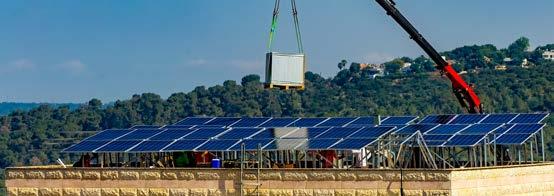
Would you like to know if your property or business can achieve energy security at the same cost or less than what you are paying currently?
Did you know that Section 12B of the Tax Act allows for the accelerated depreciation of your power generation capex resulting in a 27.5% saving on your project installation?
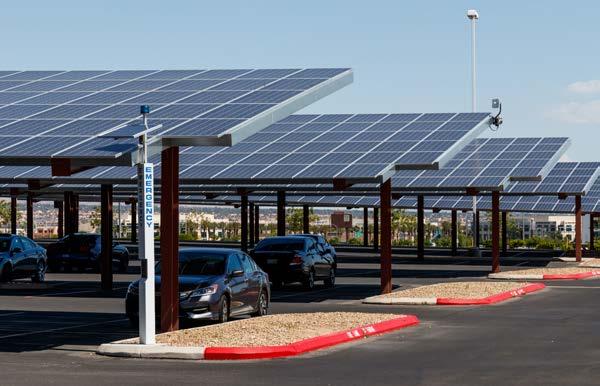
Blue Sky Energy works with leading light steel frame construction suppliers to offer a range of innovative solutions such as agrivoltaics and solar carports.
Have you considered putting your spare space to work? Whether you have low-value land or large parking spaces, bring them to life through solar PV installations that create energy and high-value spaces such as shade for parking or tunnels for agriculture.
Website: www.blue-sky.energy Email: enquiries@blue-sky.energy

Ecomondo, Italian Exhibition Group’s international trade show for the circular economy, will be opening the doors of its 26th edition with a new payoff: The Ecosystem of the Ecological Transition.

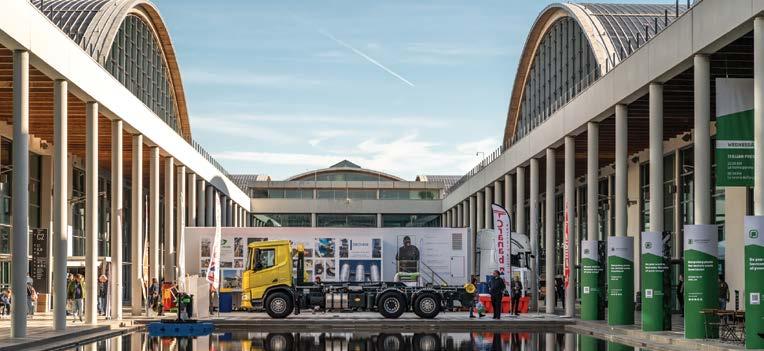
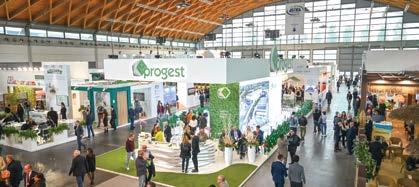
From exploiting waste to make further resources to the regeneration of soil and agro-forestry and food ecosystems, from energy obtained from biomass to the use of waste as secondary raw materials. And more still: the entire integrated water cycle and environmental monitoring, protection of the seas and aquatic environments in their essential function for human sustenance and economic activities.
Rimini will feature the WEEE District with a specific focus on repowering technologies and new systems for recycling waste from electrical and electronic equipment PV panels and wind turbine blades. In the PAPER District, the focus will be on systems for the collection, logistics and recycling of paper and cardboard in cooperation with COMIECO. Lastly, a themed itinerary will be dedicated to the production of plastics.
The textile industry has been identified as a key value chain for which the EU has foreseen actions to promote its sustainability, circularity, traceability and transparency. Key factors are eco-design requirements, producer responsibility schemes and labelling systems. In Rimini, ample emphasis will be placed on the entire supply chain: from production to post-consumption.
Companies and investors will have a new and larger platform for dialogue to cultivate the new generation of innovative businesses. More than 50 start-ups are expected in Rimini for the 2023 edition. IEG and Italian Trade Agency are promoting the initiative with Territorial Appeal Research, Emilia-Romagna’s regional agency (ART-ER) and Confindustria as their main partners, in addition to collaboration with National Association of Young Innovators (ANGI), to promote all-round innovation.
From fishing and aquaculture to the regeneration of ports and coastlines and seawater desalination technologies: the blue economy will include all traditional and emerging economic sectors linked to the development of Italian and Mediterranean marine resources.
WATER SUPPLY
7-10 November 2023
For the 2023 edition, Ecomondo will explore frontline themes. Millennials and Generation Z are showing considerable sensitivity towards environmental protection and IEG’s event acts as a platform of ideas to give shape to today’s technological research and create tomorrow’s jobs. Exchange of knowledge, access to research tenders and European funding: Ecomondo addresses the new generations so that they can participate in the ecological transition.
Ecomondo will offer its community a full programme of conventions and conferences organised under the aegis of the Technical-Scientific Committee, directed by Professor Fabio Fava from Bologna University, in collaboration with the event’s main institutional and technical partners, together with the international board that includes experts from the European Commission, OECD, FAO, UfM, EEA and ISWA.
The Ministry for the Environment and Energy Security, the Ministry for Foreign Affairs and International Cooperation and ITA, together with the increasing participation of executives from the European Commission, will be joined by CONAI, Utilitalia, CIB, CIC, CONAU, Assoambiente, Cisa Ambiente, the Foundation for Sustainable Development and National Green Economy Council as institutional partners of the event, as well as the Kyoto Club, Legambiente, Federazione ANIE, FIRE, ANFIA, ISPRA, Water Europe, ISWA and WBA.
With a 58% increase in foreign visitation compared to 2021, the involvement of profiled operators from the Balkan area, non-EU Europe, North Africa (Egypt, Morocco, Tunisia), Senegal, Ivory Coast, Angola, Ghana, Rwanda, the Middle East, as well as Canada, Latin America, the US and China will continue for the next edition. The second edition of the Africa Green Growth Forum will be staged thanks to the contribution of prestigious international agencies, such as the Union for the Mediterranean and UNIDO, non-profit organisations, including Res4Africa, Business Council for Africa. https://en.ecomondo.com/
Waste as Resource, Sites & Soil Restoration, Circular & Regenerative Bio-economy, Bio-Energy & Agroecology, Water Cycle & Blue Economy, Environmental Monitoring & Control will be the themed exhibition areas at Ecomondo 2023.



As South Africa ramps up its roll-out of renewable energy, it is now confronting the same challenge faced by countries across the globe. Depleted grid capacity in resource-rich areas is making it increasingly difficult to connect new renewable energy projects to the grid, particularly in the Northern, Eastern and Western Cape.
BY KRISTIN ENGEL*he simple truth stands that if there is no grid capacity in the country, there is no more renewable energy and there is no future for renewable energy. This will continue to cripple the energy system and our economy.” These were the words of Niveshen Govender, CEO of the South African Wind Energy Association (SAWEA), after commemorating Global Wind Day during a panel discussion hosted in Cape Town in June by renewable energy company Red Rocket.
Govender referred to the recent Renewable Energy Grid Survey released by Eskom, SAWEA and the South African Photovoltaic Industry Association (SAPVIA) earlier in June 2023, indicating there would be around 30GW of wind energy projects in various stages of development across the country over the next 10 years – increasing tenfold South Africa’s current installed wind energy capacity of 3.4GW. This 30GW of wind energy is part of a total of 66GW of renewable energy projects in the pipeline.
SAWEA believes there is massive potential for wind energy, with South Africa now considering the feasibility of offshore wind and wind-powered green hydrogen production.
Govender said: “This increases the South African potential for new wind generation to more than 100 [GW] in the next 10 years. On Global Wind Day, it is important that we encourage governments, businesses and individuals to invest in wind, support research and development,
and embrace policies to accelerate the deployment not just in South Africa, but globally.”
However, the biggest stumbling block remains the depleted grid capacity to connect new renewable energy plants in resource-rich areas around the country.
According to Eskom’s current Generation Connection Capacity Assessment (GCCA), grid capacity in the Northern and Western Cape is fully depleted, while the Eastern Cape has worryingly low grid capacity.

There are variations of capacity in each of the other provinces, with a total remaining grid capacity of about 22.754MW. Grid access requires independent power producers (IPPs) to apply for a cost estimate letter – this provides a good indication of the interest in grid access in each province. Eskom said the interest in each province currently exceeds grid capacity, except for Gauteng, Mpumalanga and KwaZulu-Natal.
Eskom’s Transmission Development Plan 2023-2032 is aimed at supporting grid expansion for both public and private IPP projects, which is aligned with the amount of renewable energy that needs to be connected. However, Govender said the timelines didn’t seem to align. He said although there was a strong policy framework to support the rollout of renewable energy, and wind energy specifically, they continued to choke on implementation.
Grid congestion is not unique to South Africa – several countries are facing the same problems – but perhaps the pressure to address this is felt more urgently in South Africa as daily rolling blackouts continue to damage all sectors of the economy.
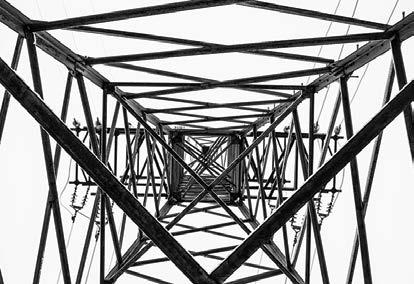
Brian Cunningham, commercial and industrial (C&I) development manager at Cape Town-based Red Rocket, said: “The grid constraints currently are in the Northern, Eastern and Western Cape and a huge amount of renewable projects now are effectively on ice until the grid can be resolved. Unfortunately for Eskom, they do not know which projects are going to be successful, and it’s challenging to try to resolve the whole grid (in all the regions at the same time).
“It’s my opinion that more than likely, things will move to a stage where IPPs are going to resolve the grid constraints through co-creation with Eskom and potentially with large C&I clients.”
Even though there are severe grid constraints, the interest in developing wind energy projects is higher than ever. Cunningham said many new wind projects were being developed in areas where the grid wasn’t constrained.
IPPs are moving out to the less windy areas.
“If there’s no grid capacity in the country, then we’re all in a difficult position, but the IPPs are very good at finding solutions and we can do that in partnership with Eskom.
“As Red Rocket, we’re always in discussions and looking for solutions with the IPP office within the Department of Mineral Resources and Energy to find novel ways to unlock the grid, in partnership and as a team effort,” he said.
Eskom spokesperson Daphne Mokwena confirmed that the power utility is preparing to issue updated grid queuing rules to better manage limited grid connection capacity in Eskom’s Interim Grid Capacity Allocation Rules document.
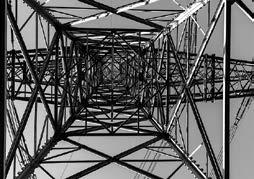

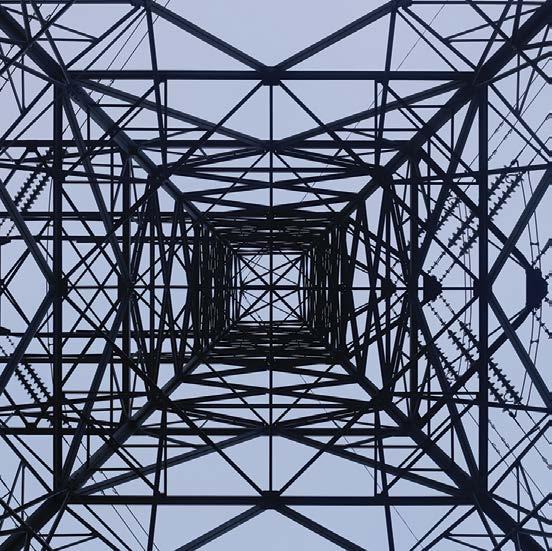
“The rules are developed to allocate grid capacity to projects that are shovel-ready, thereby avoiding the hogging of capacity. Eskom has plans, such as the Transmission Development Plan 2023-2032, to support the grid expansion for public and private IPP projects.
“The Generation Connection Capacity Assessment 2025 will be used to support the confirmation of available grid capacity (including onshore wind projects),” Mokwena said.
In the sixth bid window of the Renewable Energy Independent Power Producer Procurement Programme, no new wind generation was procured, and, according to experts and stakeholders in the
industry, this was directly due to the fact that grid capacity had been taken up in the Eastern, Northern and Western Cape and no new projects could be allowed in these areas without further studies.
Eskom said: “The large volumes of capacity for renewables exceed the local network capacity and many new long-distance lines are required. This is detailed in the Transmission Development Plan 2023-2032, which expands the grid capacity connection to 44.6GW by 2032.”
CSIR senior energy researcher, Monique le Roux, said these areas are the best wind resource locations in the country and are where most wind development has taken place.
“More development of wind power projects has taken place in other provinces recently as there is more grid capacity available, but there are definitely questions around the viability of these projects and the cost of wind power produced by these projects due to the low wind resource in these areas,” she said.
According to Le Roux, generation from renewable energy can be constructed quickly and it will therefore remain one of the best new generation sources to resolve capacity constraints and help to alleviate the electricity crisis.
There is growing pressure on government for more short-term grid optimisation solutions to be considered to open grid capacity soon and address the immediate problem. Le Roux said: “The most probable short-term solution would be to have agreements with renewable generators to curtail some of their power during peak generation periods so that transmission lines are not overloaded.”
Eskom could also look at the rollout of battery energy storage systems or fast-track transmission grid upgrades. But an updated Integrated Resource Plan (IRP) is crucial in identifying the leastcost generation options so that planning can happen accordingly, rather than taking a shotgun approach and just hoping that the least-cost option is being implemented, potentially wasting billions of rands.

Le Roux delved into the root causes of the grid constraints and explained that the South African grid was originally designed around large coal-fired power stations that generated power centrally in the north of the country. This power was then transmitted via high-voltage lines to customers in the southern parts. However, there is now a reverse in power flow, where power is generated in the south of the country where renewable energy resources are more abundant, and then transported to the north where most of the electricity users live.
“These transmission lines have a limited capacity and at present, when all the approved wind and solar generators in the Northern, Western and Eastern Cape are generating at maximum capacity, the lines can become overloaded trying to export the power in these areas.
*Written by Kristin Engel, Daily Maverick“The lines have thus reached their thermal limit and any additional generation that is added can cause them to overheat, thereby damaging the power lines,” she said.



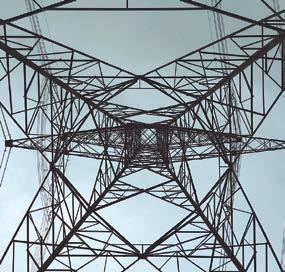


To aid the rollout of large-scale renewable power generation, investment and upgrades of the transmission network will be necessary. This issue is being encountered globally where countries have invested in renewable energy and have had to scale back on those plans due to transmission grid constraints.
“This is one of the hidden costs of renewable energy generation that is not properly accounted for and planned for and was not included in the IRP 2019 – it is going to increase the cost of renewable energy considerably in future,” said Le Roux.
An updated Integrated Resource Plan is crucial in identifying the least-cost generation options.
As thousands of South Africans switch to alternative power supply systems, municipalities have warned of the potential fire risks. And insurers are unlikely to pay out claims if your installation was not approved by your municipality.
BY NEESA MOODLEYThe Cape Town municipality’s Fire and Rescue Service says the increased use of items such as solar installations, generators and inverters powered by rechargeable batteries has caused the department to revisit its incident management playbook.
“While these devices are fulfilling a crucial role in keeping users’ lights on, and keeping their businesses going during loadshedding, users are also reminded that they can pose a risk if not installed, stored or utilised properly. In fact, systems that are not installed properly, safely and legally are one of the largest contributors to extended power outages,” says the City of Cape Town.
To minimise the potential damage, municipalities require all solar PV and/or battery systems to be installed by a competent installer who must provide a Certificate of Compliance. All systems that are connected to the wiring of the building must be registered with the City of Cape Town before installation and, from October, only city-approved inverters will be accepted for these systems. This is to reduce the risk of electrocution of those working on electrical grids and to speed up the solar system authorisation turnaround time.
Christelle Colman, the co-founder of Ami Underwriting Managers, says more fire-related claims are coming through now as solar installations increase. “The last thing you need in that scenario is to have your house burn down and realise that it was the result of a faulty solar installation,” she warns.
• Four people overcome by fumes from a generator in Parow, with one death.
• A gas explosion at a home in Hout Bay that was caused by the gas source not being switched off and resulted in one person sustaining burn wounds.
• A fire on a truck transporting lithium-ion batteries. Firefighters managed to prevent the fire from spreading to the trailer, avoiding a major hazard.

• The batteries on an inverter in a store within a mall ignited, resulting in the mall having to close its doors while the incident was attended to.
• Solar panels on a factory roof caused the wires to arch, resulting in a fire. Firefighters had to wait for technicians to isolate the panels before they could extinguish the fire.
• A fire was caused at a neighbouring property after a battery bank overheated because of insufficient ventilation.
Municipalities require all solar PV and/or battery systems to be installed by a competent installer.
• Ask if the solar PV service provider has substantial experience, with references.
• Ask whether the solar PV service provider designed, supplied and installed the system or only carried out one or two of these steps.
• The PV service provider should be accredited with a third-party quality assurance programme such as a SAPVIA’s PV Green Card.
• The installer must apply to the City to authorise the system for grid connection to ensure the safety of the electrical network, your home and all who work on the electrical grids.
• If City staff and contractors do not know about systems connected to the grid, they run the risk of electrocution.
• Authorisation must be obtained from the City before installation.
• Get a structural engineering assessment – make sure your roof can withstand the weight and wind load of solar PV panels.
• You will need building plans approved if the panels protrude more than 600mm above the highest point of the roof or are raised more than 1.5m above any point on the roof, or if ground-mounted, the panels in their installed position project more than 2.1m above the natural/finished ground level.
The Mayoral Committee member for safety and security, JP Smith, says while the city appreciates that residents want to protect themselves from the impacts of loadshedding, the incidents highlight the need to be cautious and vigilant about how energy solutions are used and stored.
“Ventilation is a key consideration, due to the risk of noxious gases from the use of petrol or diesel, but there is also the very real risk of devices overheating and catching fire. In the event of a fire, these new-age batteries also require very specific firefighting methods, so households and businesses need to ensure that they have the correct fire extinguishers on hand for their specific needs,” he says.
Electrical equipment not switched off before the power comes back on after loadshedding, and incorrectly installed or unapproved solar PV and/or battery systems increase the risk of circuits tripping and fire hazards.


When ensuring that South Africa’s fast-growing renewable energy sector projects have strong foundations – literally – it is vital that ground conditions are understood as early as possible in the project life cycle.
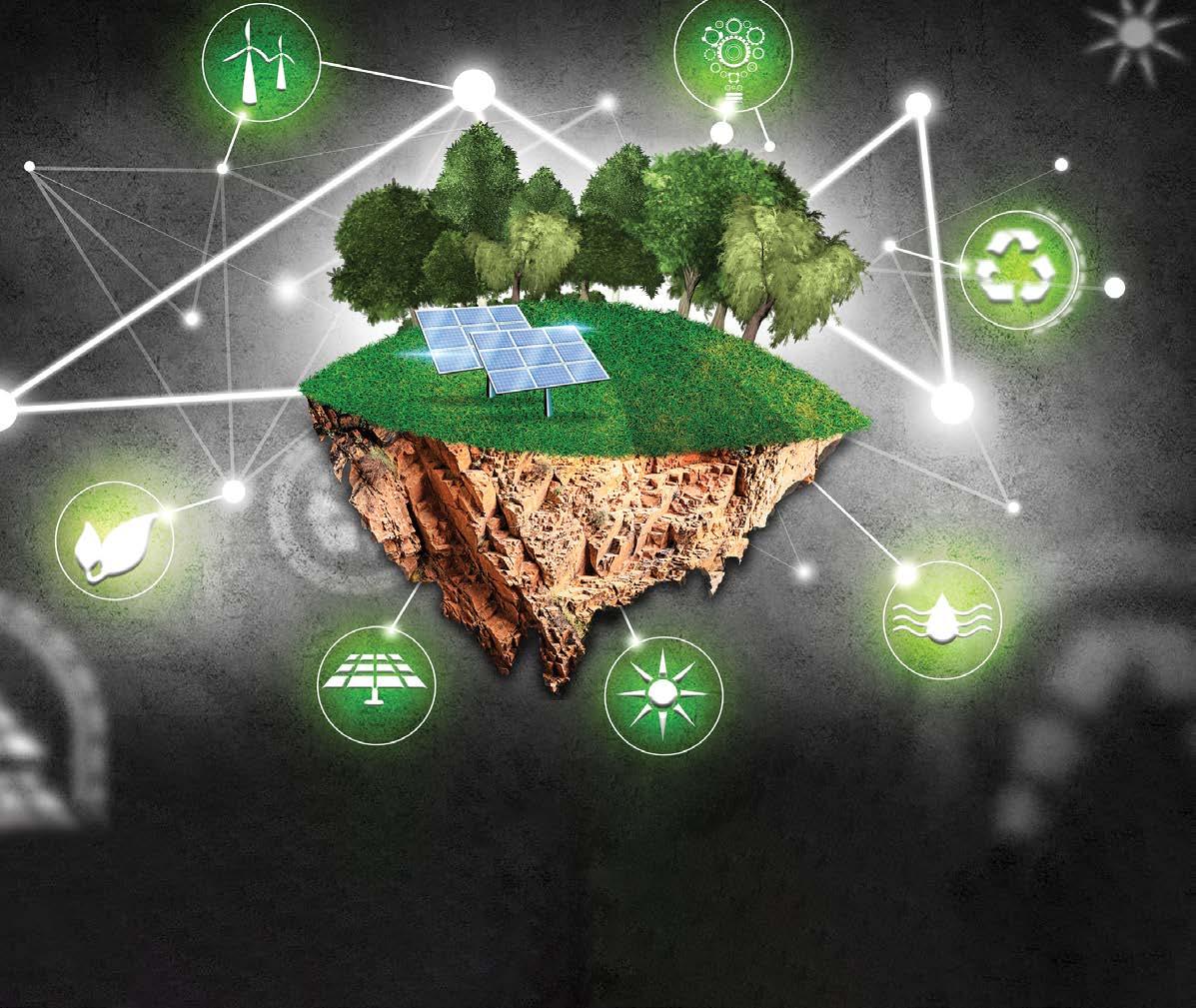 BY SRK CONSULTING*
BY SRK CONSULTING*
As part of the SRK Consulting global network of engineers and scientists, SRK Consulting (South Africa) has been extensively involved in geotechnical work on the country’s renewable energy projects. This includes wind farms and solar projects from the Western Cape to Limpopo, according to Daniell du Preez, engineering geologist at SRK Consulting. Du Preez is often one of the first people on site – and in the case of the oftenremote location of these projects, this presents various challenges.
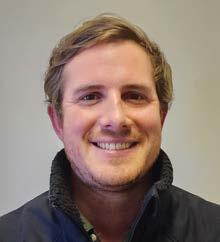
“The country’s wind farms, for instance, are often in remote, inhospitable and mountainous areas,” he explains. “Heavy machinery like drill rigs or excavators are usually necessary when investigating ground conditions, so we first need to create the roads so that this equipment can get to site – a process that can take weeks.”
On a wind farm, the turbines are usually some distance apart, so the travel distances even on a single site can be significant. Ground conditions on these projects are vital to fully understand and address, as wind turbines exert huge forces on their base and appropriately designed foundations must be expertly engineered. Wind turbine manufacturers have specific site investigation requirements which need to be followed in collaboration with the project developer, design engineer and EPC contractor. SRK designs a geotechnical investigation programme according to these specifications.
“The geotechnical work will generally be approached in various phases – with the first phase being a preliminary investigation which includes a desktop overview and site investigation which
involves drilling, test pitting, geophysical surveys, laboratory testing and reporting, while the second is a detailed or design investigation phase which involves infill testing and/or testing at each wind turbine including a continuous surface wave (CSW) test where applicable,” he says. “The next phase is when construction takes place, and where we assist with foundation inspections.”
Drilling provides engineers with a geological profile to identify a competent founding horizon which is based on various geotechnical parameters such as load bearing, and settlement. If the foundation is in rock, the rock-quality designation, fracture frequency, joint spacings and other factors are also considered.
So undeveloped are many of these sites that there is seldom easy access to water – which is necessary for various operational purposes including the drilling operations. Du Preez points out that collaboration with local farmers is often necessary to overcome the myriad practical challenges.

Once the ground conditions are analysed and SRK Consulting gives its recommendations, final foundation designs can be confirmed.
“As with all our work, SRK Consulting adheres to quality guidelines and practices of local and international relevance (Eurocode 7 – EN 1997),” he explains. “An important reference here is the Site Investigation Code of Practice South African Institution of Civil Engineering’s Geotechnical Division.”
This code requires that, at development or feasibility phase, a geotechnical data test point must be gathered from the site of each wind turbine structure. As the project develops through to detailed design phase further test points might be required. The contractor can also use SRK Consulting professionals for turbine base inspections before the casting of concrete – to ensure that the correct levels, depths and other criteria have been achieved before formwork and concrete work begins.
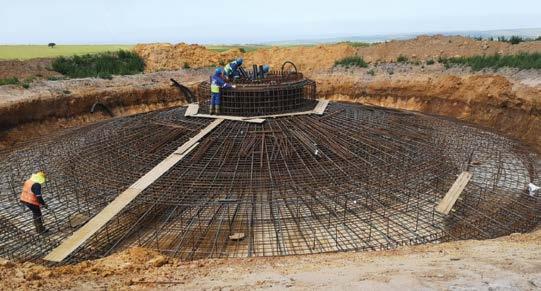
With South Africa’s high solar radiation index – a daily average of 220 watts per square metre compared with 150 for parts of the USA and about 100 for Europe – photovoltaic (PV) installations are proving to be valuable contributors to the energy mix. The key geotechnical
elements of planning most of these PV projects relate to the stability of the posts holding the solar panels. Acknowledging that various installation methods exist; the most feasible method is generally the pile post method. This usually involves pre-drilling and piling to secure the posts, but it is not always that simple, Du Preez says.
“Where possible, we advise clients to take a phased approach, as it is not always exactly clear in advance what the ground conditions will be,” he adds. “Rather than mobilise a full fleet of drilling equipment from the start, it is usually more cost effective to begin with a test pitting phase – as you might discover that there is bedrock or competent founding conditions at a shallow depth.”
Du Preez therefore prefers going to site initially with an excavator (or backhoe) and Dynamic Probe Light (DPL) equipment to conduct test pits and DPLs across the site – down to three metres or earlier refusal – to find the suitable founding horizon. If a competent founding horizon is not encountered by these means, then a second phase can be initiated, using a Dynamic Probing Super Heavy (DPSH) rig and even a drill rig to conduct core drilling and standard penetration test (SPT). The DPSH rig and SPT testing is specially designed for testing the in-situ consistency of soil, to provide a measure or indication of the ground conditions ie establishing stiff or softer soil layers at depth.
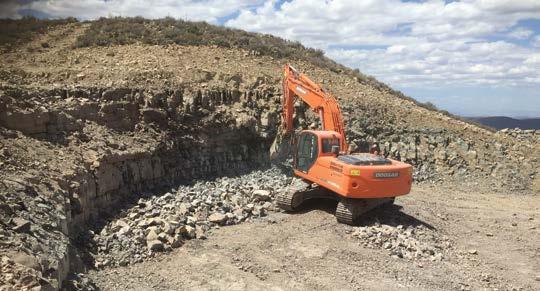
“Even if bedrock is not encountered, there may be a competent horizon at shallower depth – which may allow piling without any pre-drilling,” he says. “While it may still be worth applying DPSH technology to these conditions to determine skin friction and to complement the DPL results, this approach could save considerable unnecessary cost.”
A pull-out test is generally considered as the last phase which is a valuable intervention to prove the skin friction and stiffness of the post. This data will assist the design engineer to ensure that the posts are well mounted and stable.
With its multi-disciplinary approach and range of inhouse skills, SRK Consulting’s work on renewable energy projects extends well beyond geotechnical work and includes environmental impact assessments (EIAs) and associated specialist studies, such as in-house groundwater, surface water, air quality and visual impact studies, as well as ecological, avifauna, aquatic ecology, noise, heritage and socio-economic studies.
The latter assesses how a project affects local communities, aiming to minimise negative impacts and leverage the positive spin-off in terms of local job creation and skills development.
Ground conditions on these projects are vital to understanding the founding method.*Article written by Daniell du Preez, Engineering Geologist, SRK Consulting.


SA’s economy is facing a magnitude of issues that are hampering both the prosperity of its people and the businesses that operate within it – and to say we are almost at the end of it, is truly an understatement – but is there light at the end of the tunnel?
 BY KATE STUBBS, INTERWASTE
BY KATE STUBBS, INTERWASTE

Not only are we in the throes of one of the worst power crises the country has seen but so too are we faced with a water crisis, a growing population putting pressure on already strained resources and climate concerns. However, not all is lost, and this should be a clear message to business and government.
There are solutions that can drive sustainability within key sectors that serve South African consumers and the economy. It merely means looking deeper than the obvious solutions and finding ways to unilaterally work together to ensure such resolutions become viable and cost effective, and to ensure that we drive an understanding in communities as to the vital importance of such innovations in meeting South Africa’s challenges and being part of the change.
For us, effective waste management and the ability to use waste in creating a circular economy provides a critical pillar to such innovation. Not only does proper waste management ensure that we can reuse and repurpose the growing mound of waste being generated but it ensures that, where waste cannot be repurposed/recycled, it can be, as a last resort, sent to compliant landfills for safe disposal.
Without a doubt the waste sector plays a fundamental role in meeting the country’s Sustainable Development Goals (SDGs), tackling not one, but at least six of the 15 goals in total. Goals 6 (safe water), 7 (clean energy), 13 (climate action) and 11 (sustainable cities) being the most prominent in this regard. In fact, it is an integral part of these goals – where, taking the circular-economy thinking into account, where waste reuse and repurposing is fundamental to meeting these objectives and addressing environmental impact and growing ESG targets globally.
However, we have a conundrum where many people, businesses and some levels of government are under-informed about the potential of well-managed, compliant and innovative waste management solutions. The reality though, is that with a population of 61-million people growing by around 1% a year, and with each person generating around two kilograms of waste per day, we are heading towards a waste disaster if we do not start creating solutions and ensuring that all parties are educated as to why effective waste management is so important.
With seven of the 13 major water systems in South Africa predicted to be in deficit by 2040 and the demand for water expected to exceed
available supply by 2030, we need to find solutions. In our experience wastewater management can result in the redistribution of water into the environment for irrigation and dust suppression, as well as to replenish rivers and catchments in our water infrastructure networks. Furthermore, treated to the required standards, we have found that nearly all effluent can be recycled, if done properly, creating a strong solution for water sustainability and access – water that was previously not deemed safe for consumption. We need to create a much more diverse water mix, including groundwater and wastewater reuse, if we hope to protect this scarce resource and create a water supply that is safe and of consistent quality.
Waste can tackle energy crises but needs solid business, government and industry collaboration to see it to fruition. If we consider the Just Energy Transition’s provision focus on achieving net-zero carbon emissions by 2050, exploring alternative sustainable options is key and if we consider that the global waste-to-energy market is expected to grow from USD28.4-billion in 2017, to almost USD43-billion in 2024, waste presents a large economic opportunity to establish new industries and/or revenue streams and meet SDG Goals.
Converting waste to energy production occurs through three key processes: thermal, biological and physical. For each process, there are a variety of technologies available to convert different types of waste to energy such as electricity, steam or gas and so, there are multiple layers to meeting South Africa’s energy crisis – critical to government agendas currently.
This reiterates the importance of not only alternative solutions to meeting South Africa’s challenges but indicates the fundamental role of effective, ethical and compliant waste management practices in driving South Africa’s climate agenda. The challenge is large but so are the solutions –we must create strong industry collaboration and investment projects that are supported by communities to truly change the status quo.
Kate Stubbs, Director Business Development and Marketing, Interwaste.
Waste can tackle energy crises but needs solid business, government and industry collaboration to see it to fruition.

Circular economy has become quite the buzzword globally as nations start adopting the primary principles, sometimes inadvertently, to achieve sustainability goals, climate adaptation/mitigation goals, the SDGs and ESG reporting.
 BY CHRIS WHYTE, ACEN*
BY CHRIS WHYTE, ACEN*
Unfortunately, Africa has been a bit slow on adopting the jargon, with many still believing this is just another fancy word for recycling and everyone in the waste management and recycling sectors proudly claiming their circular credentials. The reality is that the circular economy is far more than just a waste-focus. When asked to write a circular economy article for this issue of the Journal based on one of the six sectors to be highlighted, I didn’t know where to start.
Chris Whyte.I could write reams on each sector, but my dilemma was that selecting one would be as disingenuous as lumping circular economy with waste management. “What about the Nexus?” I cried. “I want to do all of them!” To which the response from the editor was, “Pick one – and what’s a Nexus?”
So, in my obstinate grumpiness I have decided to expand on the nexus and take my chances that the editor will indulge my will and let this one slip though, else se la vie

What’s a nexus? Essentially a nexus is the inextricable link between sectors that warrants their co-management to ensure the goals of each are achieved equally. Humans like to put things in boxes. Even more so in government, where boxes are upgraded to impenetrable armoured silos. When one thing does not work without the other, this tends to be a management disaster, but forbid the thought we should change the way we do things, else we might fix this country…
The most common nexus discussions globally are those of the Water/Energy/Food or WEF nexus. Quite simply, we can’t grow food without water, and we need energy to move water to where it is supposed to be and to process food and get it to market. In their natural states, water (rain), energy (sunlight) and food (plants) all work in harmony, but mankind has somewhat disrupted this harmonic continuum. We cannot manage our way out of this disruption if we consider these sectors separately and thus the nexus.
However, the deeper you go into this the more you realise that everything is connected. Like the topics in this Journal issue. As an




example, one should not consider manufacturing without considering water, energy, transport, infrastructure, materials, etc. One can make the same assumptions with each of the topics in this issue, with some less obvious than the others.
Construction is a vital component of a sustainable transition with the built environment collectively contributing some 39% of all carbon emissions driving global warming. Again, this is not just about the waste (eg builders’ rubble gaining a second life), but making a paradigm shift to new low-carbon materials, design and innovation. We need to embrace new materials and change our preference from energy-hungry conventional options like cement (solely responsible for 8% of global emissions!). “How?” you may ask, but fear not – most of the solutions are available already. We just need to change. Talking about the nexus, even construction has a nexus involving materials, waste, energy, water and logistics.
New innovative materials can be lighter, cheaper, more thermally efficient, low-carbon, stronger and better in so many ways. We
Everything is connected as nature intended, and nature is good.
need to disrupt the vested interests in the conventional materials sector, else drag them kicking and screaming into the 21st century. Sometimes it is not just the obvious. Science, technology and innovation are leading the way. One of the projects I am working on now is using innovation to take one country’s waste from the construction sector to manufacture mineral-based replacements to steel. This offsets imports of a material that has one of the highest carbon footprints; using local waste that currently costs a fortune to dump; at less than half the price and a fifth of the weight; that does not have the same corrosive relationship to concrete that limits the lifespan of buildings.
Renewable energy is another topic of this issue and mooted as the saviour of the planet. Before we all jump on this bandwagon, we also need to understand the nexus and Life Cycle Analysis. Renewable energy has its own embodied energy (the materials and energy needed to create the infrastructure) and has its own nexus with energy, water, materials and land. Still way better than fossil fuels from an impact perspective post-construction, but to make it truly circular we are also going to have to embrace end-of-life options for all those old solar panels, batteries and wind turbines to bring these materials back into circulation.
Without this strategy, all we are going to do is fuel the mining sector to extract more virgin materials from the earth. Already we are seeing policy directives from the global North around “critical raw materials” that we are running out of rapidly and fuelling international tensions. Circularity poses a solution to this under the option of Materials as a Service, dubbed MaaS. Effectively, this is a strategy that offers a future safety net for manufacturers in dealing with materials sourcing issues, where material suppliers offer manufacturers the use of materials through services while retaining ownership. This makes sense in that if the supplier owns the material, the manufacturer will ensure design that promotes longevity and ultimate return of the facility to ensure the materials can be recycled and used again. It gets complicated but makes so much sense in ensuring that no materials are lost as we see in our current throw-away mindset.

You don’t own your cell phone – you rent the use of it from the manufacturer who in turn is borrowing the materials from the supplier who retains ownership of that. This could change the world in so many positive ways and take the burden off the consumer who pays a fortune for the latest cell phone only to throw it away in two years when the next best comes out…
It’s a fresh new world full of exciting opportunities – we just need to embrace it and understand the nexus. Everything is connected as nature intended, and nature is good.




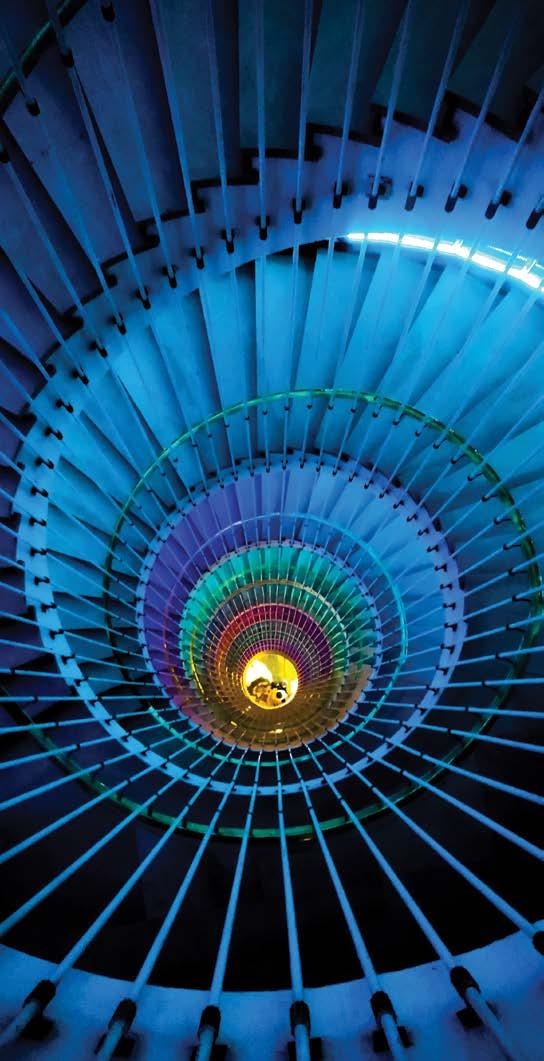
Water (rain), energy (sunlight) and food (plants) all work in harmony, but mankind has somewhat disrupted this harmonic continuum.

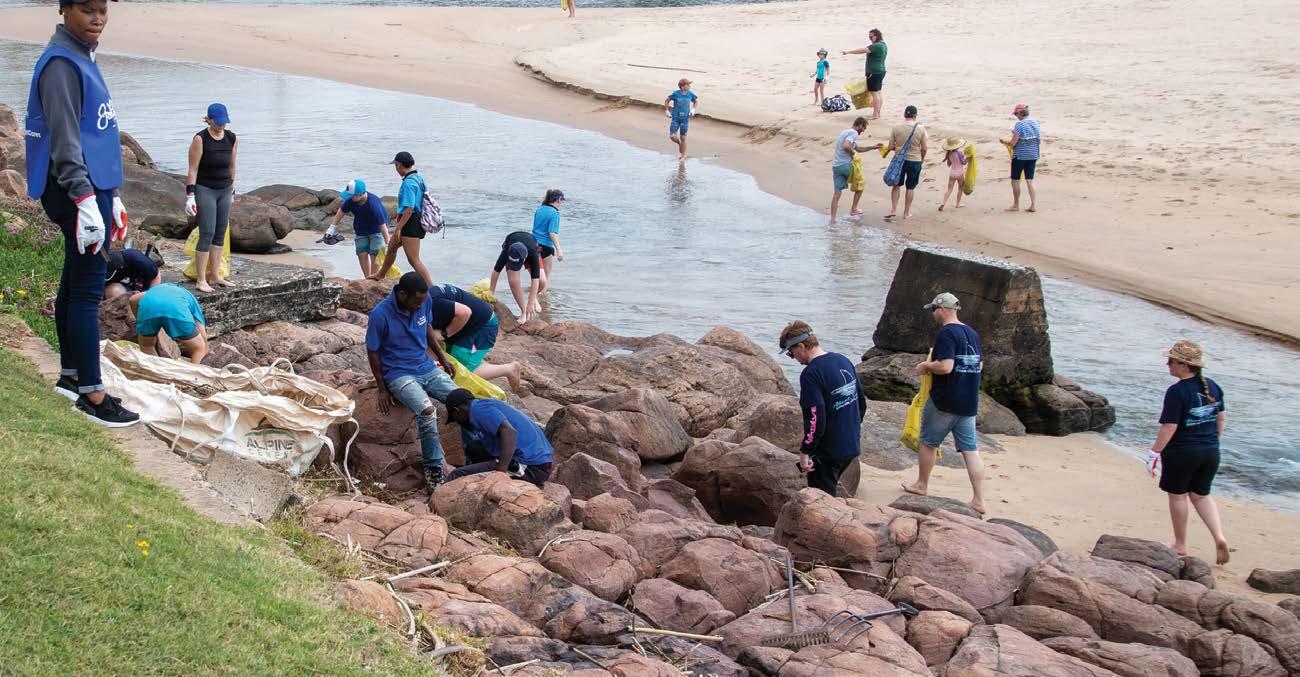
South Africa is not only known for its stunning coastlines but also for its commitment to preserving them. Plastics SA’s annual Clean-Up & Recycle SA Week, which will take place this year from 11-16 September 2023, plays a pivotal role in promoting environmental sustainability and combating the waste crisis plaguing our beautiful country.
“Plastics SA is proud to announce its 27th year of coordinating South Africa’s active participation in the International Coastal Clean-up Day (ICC), taking place at beaches across the country and around the world on Saturday, 16 September 2023, which will also be World Clean-Up Day. This year the Clean-Up & Recycle SA Week will again feature numerous clean-ups on beaches, at rivers, water sources and in communities and neighbourhoods around the country.
Highlights of the week include National River Clean-up Day on Wednesday, 13 September and National Recycling Day SA on Friday, 15 September. The culmination of the week’s activities will be on Saturday, 16 September, when South Africans from all walks of life come together for International Coastal Clean-up Day and World Clean-up Day,” says Douw Steyn, sustainability director at Plastics SA.
To further emphasise their dedication and aid in clean-up activities, Plastics SA has increased the number of yellow refuse bags to an impressive 700 000, ensuring that the industry and coordinators of clean-ups can make a substantial impact on cleaning up our beaches and rivers. Cleanup champions in Gauteng and Mpumalanga will also be recognised and rewarded with essential clean-up tools ie of bags, gumboots, gloves, rakes and other equipment needed to clean the roadsides and rivers on River Clean-up Day.
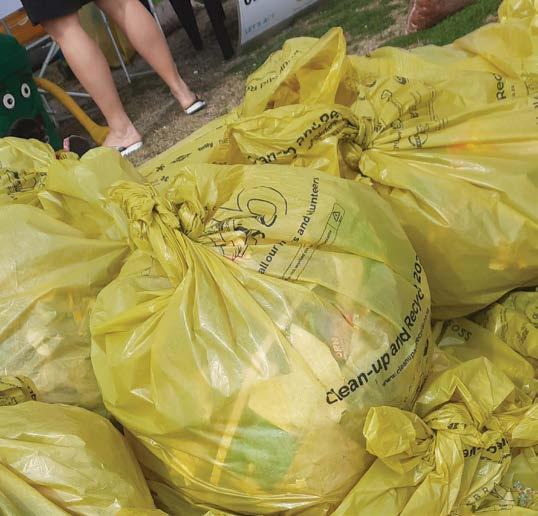
“South Africa is facing a waste crisis, and every citizen can make a difference to reduce the amount of litter that pollutes our environment or ends up in landfill. As far as possible, we try to ensure that all the clean-ups that we support are audited and that volunteers register online on our www.cleanupandrecycle.co.za website. This allows us to build a detailed snapshot of the waste landscape in the country, the number of people who participated and how we as an industry can respond and provide support to community initiatives,” Douw says.
“During the entire month of September, Plastics SA with the support of all packaging streams, Producer Responsibility Organisations (PROs), various sponsors, businesses and industries, as well as national and local government entities, community organisations and municipalities
will be conducting clean-ups in an effort to raise awareness about the importance of effective waste management and recycling. This collective effort underscores the importance of collaborative action in addressing environmental challenges. We encourage South Africans from all walks of life to make a difference where they work, live, learn or play this September by participating or coordinating a clean-up to create a cleaner, greener South Africa. Together, we can make a lasting difference!” Douw concludes.
For more information about Plastics SA and the Clean-Up & Recycle SA Week, please visit www.plasticsinfo.co.za or www.cleanupandrecycle.co.za.
We encourage South Africans from all walks of life to make a difference.




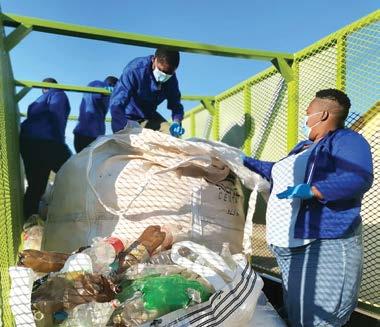
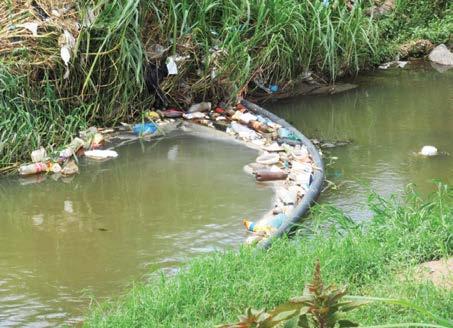
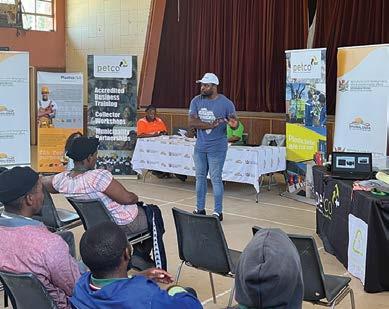
In this edition, we delve into some of the specifics arising out of South Africa’s dire water situation. While there is a myriad of negatives, there is also an upside with many multinationals considering regional offices in anticipation of the Water and Sanitation Masterplan implementation.

Let’s first look at municipal capex budgets for the next three years. The metropolitan municipalities are a good starting point as there are seven of the eight included in this narrative, representing some 24-million citizens, around 40% of South Africa’s population.
included in the new cities and towns proclaimed where these municipalities simply could not provide the traditional centralised water and sanitation services.
A range of locally and internationally developed package plants for water and sewage treatment was rapidly rolled out by mostly local EPCs and government issued guidelines to try and assist municipalities in managing this process. The success rates were not impressive as municipalities failed to govern the rollout and enforce operational compliance resulting in many still resisting this approach.
Decentralised approaches in many sectors have been made very competitive with the miniaturisation and scale of deployment. In the water sector, this is not as developed and can often result in higher costs of ownership when comparing apples with apples.
In South Africa’s metropolitans, there is a wide range per capita capex spend annually (from R800 to R2 900) with the largest metro, City of Johannesburg, spending below the metropolitan average by 20%, which we can see is affecting service delivery negatively with ongoing reports of major water outages. This picture does not bode well for our metropolitans and it’s clear we need to up the spend and its efficacy in implementation considerably more in most of the metropolitan municipalities to achieve water security for all.
The second topic gaining major attention in South Africa is the subject of decentralised and package plants. South Africa started on this journey over two decades ago when the new municipal demarcations resulted in major underserviced regions being
However, one major driver recently is to lower the energy needed to convey sewage for example due to high energy prices and to enable the development of housing and commercial-industrial estates where the current municipalities have inadequate capacity to take on these additional loads. This is generally the case in all South African metropolitans. So, the technology exists, the need is dire and with heightened governance we should be able to better meet our development needs with decentralised solutions. There is no choice in the real world.
We are witnessing the rapid deregulation of electricity generation in South Africa purely due to Eskom’s inability to keep pace. It is my contention that we will see a similar situation unfold in the water and sanitation services sector where this needs to be managed aptly as we are dealing with society’s health and wellbeing. Local government generally lacks the bylaws to enable this process and will have to step up to the plate now to ensure a well-managed rollout process.
The digitisation (so the adaptation of a system, process, etc to be operated with the use of computers and the Internet) is a
well-established means of operating and managing our water and sanitation infrastructure in South Africa. Digitalisation, however, is the advance use of digital data to manage processes and decisionmaking using smart analytics. Smart analytics are derived from the digital operations of assets and systems by extracting, normalising, cleansing and modelling data that can inform business intelligence via reports, real-time dashboards and alerts with predictive, optimisation and anomaly detection capabilities usually using machine learning and Artificial Intelligence platforms. These are powerful tools to enable the real-time management of water assets and the optimisation of the assets before maintaining, rejuvenating and replacing them prematurely but timeously.
Like all new developments, change management is key in rolling out these digital solutions. Our water sector lags global momentum, that is itself lagging other sectors, and must find ways of expediting the adoption of new management practices given the lack of water security and technical skills available.
An example of where digitalisation is exceptional in inculcating water security is the live management of water distribution networks where non-revenue water is rampant, with South Africa close to
50% and the global average below 25%. Using digital tools to link physical assets with actual demand and managing district metering areas with pressure demand management, one can optimise the required system pressures live and reduce leaks that are prevalent in the older bulk mains. Sophisticated algorithms can assist in locating imminent pipe bursts and hence limit losses and improve preventative asset management.
Desalination receives mixed reviews mostly because of not being well understood as most do not appreciate the infrastructure complexities in producing water until their taps run dry. There are three main myths about desalination:


1. It’s expensive. It is certainly true that five decades ago desalination was in its infancy with mostly thermal desalination plants used in arid areas with no other source of water except for seawater. The prices ranged around USD10/m³ and coming down to less than USD1/m³ in 2010. The advent of reverse osmosis membranes has resulted in the latest contracted facilities in the MENA region being contracted at some USD0.30/m³ with their target for 2025 at USD0.20/m³.
2. It’s energy intensive. Thermal desalination used around 15kWh/m³ decades ago with seawater reverse osmosis now using 2.5kWh/m³ and getting close to the theoretical amount of energy required. Renewable energy to drive these desalination facilities is now the new norm in recent projects and gaining traction resulting in lowering the carbon footprint and costs of the process.
3. It’s environmentally destructive. Environmental impacts are very localised mostly in the stagnant Gulf region and not a factor in the open oceans where dispersion technologies are very effective coupled with ocean currents. The mining of brine streams is also gaining momentum as are advanced processes such as forward osmosis and membrane distillation that improve water yields in parallel.
Desalination is a climate change and rainfall independent way of providing affordable high-quality water from an infinite resource 265 days a year and cannot be ignored any further for South Africa’s coastal economies. The Water and Sanitation Masterplan of 2018 refers to the deployment of at least 1 600MGLD desalination this decade. We need to get past the talk shops!
It’s clear we need to up the spend and its efficacy in implementation.
The product of a rigorous process, including input from SAWEA’s Manufacturing and Local Content Working Groups, stakeholders have been invited to comment on the draft South African Renewable Energy Masterplan (SAREM) document.


“Together with the broader renewable energy industry, we welcome this framework, as it supports our advocacy for sector industrialisation, through increased local manufacturing. As such, we view the key pillars outlined by the document as effective interventions to create a better environment for local manufacturing, which will no doubt result in increased employment opportunities, investment, social inclusion and acceleration of our industry’s participation in a global wind supply chain,” says Niveshen Govender, CEO of SAWEA.
Designed to stimulate the industrial development of renewable energy and battery storage value chains and contribute to the broader development needs of the country, the SAREM clearly lays out a framework in which opportunities linked to the booming market for renewable energy can be accessed, both domestically and globally.
The four key pillars of SAREM focus on supporting market demand; driving industrial development; fostering inclusive development and building local capabilities.
“Along with setting clear local content targets for future private and public procurement following a consultation process, the SAREM’s focus on driving industrial development, outlines existing public sector programmes and policy support with localisation objectives. Furthermore, the plan outlines interventions to attract investment and aligns to the different national and international policies of the various government department stakeholders as well as international funding and trade institutions,” explains Govender.
As noted by SAWEA, despite initial localisation targets reflected in the 2022 draft, the SAREM has been revised to exclude specific targets at this time, which will be obtained through an inclusive negotiation process between the social partners.
“Fostering inclusive development” refers to the sectors transformation objectives, and relates to both public and private procurement. Clear transformation objectives are to be established by developing and implementing a sector-specific BBBEE scorecard with targets to be achieved upon the conclusion of the negotiation process. Local and
emerging suppliers will be supported through the development of a transformation fund.
“While the SAREM draft provides a conducive environment for localisation, responsibility remains with manufacturers to negotiate the investment and associated targets. Communities are to be involved through directing renewable energy and storage activities, linked to Just Transition hotspots, indicating that public procurement rounds could be launched in these areas. In support of this, industrial parks or Special Economic Zones, such as the Atlantis green economy hub, may further be established in these areas to support employment and skills development,” adds Govender.
Govender concludes, “An industrialisation agenda, which is rooted in robust local manufacturing capabilities, will allow the wind power sector to deliver the necessary new generation power needed for the country to thrive. To this end, the masterplan provides a clear framework, which is necessary for both local and global investors, seeking an investment destination to manufacture renewable and new generation technology components, as part of the global supply chain. It is also worth reiterating that in relation to the REIPPPP, a stable pipeline with foreseeable and predictable timelines between procurement rounds, remains necessary to attract significant investments in order to rebuild the manufacturing sector and create a local market based on its competitiveness and value-add.”

SAWEA has put its voice of support behind the release of the draft SAREM, led by the Department of Mineral Resources and Energy and the Department of Trade, Industry and Competition.Niveshen Govender, CEO of SAWEA. *South African Wind Energy Association
Sodium-sulphur batteries (NAS® Batteries), produced by NGK Insulators Ltd., and distributed by BASF, with almost 5 GWh of installed capacity worldwide, is the perfect choice for large-capacity stationary energy storage.


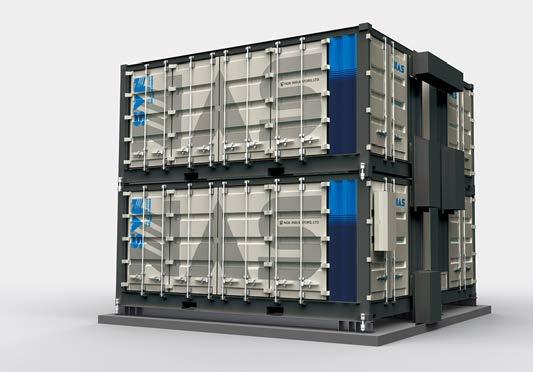
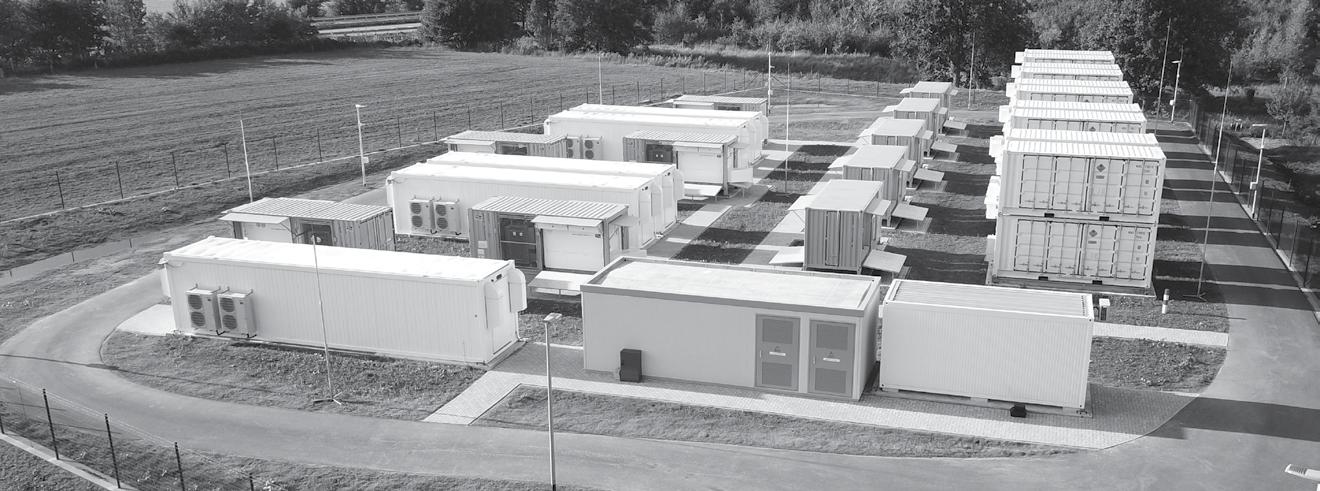


A key characteristic of NAS® Batteries is the long discharge duration (+6 hours), which makes the technology ideal for daily cycling to convert intermittent power from renewable energy into stable on-demand electricity.
NAS® Battery is a containerised solution, with a design life of 7.300 equivalent cycles or 20 years, backed with an operations and maintenance contract, factory warranties, and performance guarantees.
Superior safety, function and performance are made possible by decades of data monitoring from multiple operational installations across the world. NAS® Battery track record is unmatched by any other manufacturer.
Provide for your energy needs from renewable energy coupled with a NAS® Battery.
Contact us right away for a complimentary pre-feasibility modelling exercise to find out how a NAS® Battery solution can address your energy challenges!
Battery energy storage powered by renewable energy is the future, and it is feasible in South Africa right now!